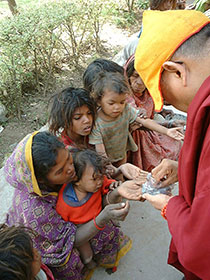- Home
- FPMT Homepage
Foundation for the Preservation of the Mahayana Tradition
The FPMT is an organization devoted to preserving and spreading Mahayana Buddhism worldwide by creating opportunities to listen, reflect, meditate, practice and actualize the unmistaken teachings of the Buddha and based on that experience spreading the Dharma to sentient beings. We provide integrated education through which people’s minds and hearts can be transformed into their highest potential for the benefit of others, inspired by an attitude of universal responsibility and service. We are committed to creating harmonious environments and helping all beings develop their full potential of infinite wisdom and compassion. Our organization is based on the Buddhist tradition of Lama Tsongkhapa of Tibet as taught to us by our founders Lama Thubten Yeshe and Lama Thubten Zopa Rinpoche.
- Willkommen
Die Stiftung zur Erhaltung der Mahayana Tradition (FPMT) ist eine Organisation, die sich weltweit für die Erhaltung und Verbreitung des Mahayana-Buddhismus einsetzt, indem sie Möglichkeiten schafft, den makellosen Lehren des Buddha zuzuhören, über sie zur reflektieren und zu meditieren und auf der Grundlage dieser Erfahrung das Dharma unter den Lebewesen zu verbreiten.
Wir bieten integrierte Schulungswege an, durch denen der Geist und das Herz der Menschen in ihr höchstes Potential verwandelt werden zum Wohl der anderen – inspiriert durch eine Haltung der universellen Verantwortung und dem Wunsch zu dienen. Wir haben uns verpflichtet, harmonische Umgebungen zu schaffen und allen Wesen zu helfen, ihr volles Potenzial unendlicher Weisheit und grenzenlosen Mitgefühls zu verwirklichen.
Unsere Organisation basiert auf der buddhistischen Tradition von Lama Tsongkhapa von Tibet, so wie sie uns von unseren Gründern Lama Thubten Yeshe und Lama Thubten Zopa Rinpoche gelehrt wird.
- Bienvenidos
La Fundación para la preservación de la tradición Mahayana (FPMT) es una organización que se dedica a preservar y difundir el budismo Mahayana en todo el mundo, creando oportunidades para escuchar, reflexionar, meditar, practicar y actualizar las enseñanzas inconfundibles de Buda y en base a esa experiencia difundir el Dharma a los seres.
Proporcionamos una educación integrada a través de la cual las mentes y los corazones de las personas se pueden transformar en su mayor potencial para el beneficio de los demás, inspirados por una actitud de responsabilidad y servicio universales. Estamos comprometidos a crear ambientes armoniosos y ayudar a todos los seres a desarrollar todo su potencial de infinita sabiduría y compasión.
Nuestra organización se basa en la tradición budista de Lama Tsongkhapa del Tíbet como nos lo enseñaron nuestros fundadores Lama Thubten Yeshe y Lama Zopa Rinpoche.
A continuación puede ver una lista de los centros y sus páginas web en su lengua preferida.
- Bienvenue
L’organisation de la FPMT a pour vocation la préservation et la diffusion du bouddhisme du mahayana dans le monde entier. Elle offre l’opportunité d’écouter, de réfléchir, de méditer, de pratiquer et de réaliser les enseignements excellents du Bouddha, pour ensuite transmettre le Dharma à tous les êtres. Nous proposons une formation intégrée grâce à laquelle le cœur et l’esprit de chacun peuvent accomplir leur potentiel le plus élevé pour le bien d’autrui, inspirés par le sens du service et une responsabilité universelle. Nous nous engageons à créer un environnement harmonieux et à aider tous les êtres à épanouir leur potentiel illimité de compassion et de sagesse. Notre organisation s’appuie sur la tradition guéloukpa de Lama Tsongkhapa du Tibet, telle qu’elle a été enseignée par nos fondateurs Lama Thoubtèn Yéshé et Lama Zopa Rinpoché.
Visitez le site de notre Editions Mahayana pour les traductions, conseils et nouvelles du Bureau international en français.
Voici une liste de centres et de leurs sites dans votre langue préférée
- Benvenuto
L’FPMT è un organizzazione il cui scopo è preservare e diffondere il Buddhismo Mahayana nel mondo, creando occasioni di ascolto, riflessione, meditazione e pratica dei perfetti insegnamenti del Buddha, al fine di attualizzare e diffondere il Dharma fra tutti gli esseri senzienti.
Offriamo un’educazione integrata, che può trasformare la mente e i cuori delle persone nel loro massimo potenziale, per il beneficio di tutti gli esseri, ispirati da un’attitudine di responsabilità universale e di servizio.
Il nostro obiettivo è quello di creare contesti armoniosi e aiutare tutti gli esseri a sviluppare in modo completo le proprie potenzialità di infinita saggezza e compassione.
La nostra organizzazione si basa sulla tradizione buddhista di Lama Tsongkhapa del Tibet, così come ci è stata insegnata dai nostri fondatori Lama Thubten Yeshe e Lama Zopa Rinpoche.
Di seguito potete trovare un elenco dei centri e dei loro siti nella lingua da voi prescelta.
- 欢迎 / 歡迎
简体中文
“护持大乘法脉基金会”( 英文简称:FPMT。全名:Foundation for the Preservation of the Mahayana Tradition) 是一个致力于护持和弘扬大乘佛法的国际佛教组织。我们提供听闻,思维,禅修,修行和实证佛陀无误教法的机会,以便让一切众生都能够享受佛法的指引和滋润。
我们全力创造和谐融洽的环境, 为人们提供解行并重的完整佛法教育,以便启发内在的环宇悲心及责任心,并开发内心所蕴藏的巨大潜能 — 无限的智慧与悲心 — 以便利益和服务一切有情。
FPMT的创办人是图腾耶喜喇嘛和喇嘛梭巴仁波切。我们所修习的是由两位上师所教导的,西藏喀巴大师的佛法传承。
繁體中文
護持大乘法脈基金會”( 英文簡稱:FPMT。全名:Found
ation for the Preservation of the Mahayana Tradition ) 是一個致力於護持和弘揚大乘佛法的國際佛教組織。我們提供聽聞, 思維,禪修,修行和實證佛陀無誤教法的機會,以便讓一切眾生都能 夠享受佛法的指引和滋潤。 我們全力創造和諧融洽的環境,
為人們提供解行並重的完整佛法教育,以便啟發內在的環宇悲心及責 任心,並開發內心所蘊藏的巨大潛能 — 無限的智慧與悲心 – – 以便利益和服務一切有情。 FPMT的創辦人是圖騰耶喜喇嘛和喇嘛梭巴仁波切。
我們所修習的是由兩位上師所教導的,西藏喀巴大師的佛法傳承。 察看道场信息:
- FPMT Homepage
- News/Media
-
- Study & Practice
-
-
- About FPMT Education Services
- Latest News
- Programs
- New to Buddhism?
- Buddhist Mind Science: Activating Your Potential
- Heart Advice for Death and Dying
- Discovering Buddhism
- Living in the Path
- Exploring Buddhism
- FPMT Basic Program
- FPMT Masters Program
- FPMT In-Depth Meditation Training
- Maitripa College
- Lotsawa Rinchen Zangpo Translator Program
- Universal Education for Compassion & Wisdom
- Online Learning Center
-
- Prayers & Practice Materials
- Overview of Prayers & Practices
- Full Catalogue of Prayers & Practice Materials
- Explore Popular Topics
- Benefiting Animals
- Chenrezig Resources
- Death & Dying Resources
- Lama Chopa (Guru Puja)
- Lama Zopa Rinpoche: Compendium of Precious Instructions
- Lama Zopa Rinpoche: Life Practice Advice
- Lama Zopa Rinpoche Practice Series
- Lamrim Resources
- Mantras
- Prayer Book Updates
- Purification Practices
- Sutras
- Thought Transformation (Lojong)
- Audio Materials
- Dharma Dates - Tibetan Calendar
- Translation Services
- Publishing Services
- Ways to Offer Support
- Prayers & Practice Materials
-
- Teachings and Advice
- Find Teachings and Advice
- Lama Zopa Rinpoche Advice Page
- Lama Zopa Rinpoche: Compendium of Precious Instructions
- Lama Zopa Rinpoche Video Teachings
- ༧སྐྱབས་རྗེ་བཟོད་པ་རིན་པོ་ཆེ་མཆོག་ནས་སྩལ་བའི་བཀའ་སློབ་བརྙན་འཕྲིན།
- Podcasts
- Lama Yeshe Wisdom Archive
- Buddhism FAQ
- Dharma for Young People
- Resources on Holy Objects
- Teachings and Advice
-
-
*If a menu item has a submenu clicking once will expand the menu clicking twice will open the page.
-
-
- Centers
-
- Teachers
-
- Projects
-
-
-
-
*If a menu item has a submenu clicking once will expand the menu clicking twice will open the page.
-
-
- FPMT
-
-
-
-
-
No matter whether you are a believer or a non-believer, religious or not religious, a Christian, Hindu, or a scientist, black or white, an Easterner or a Westerner, the most important thing to know is your own mind and how it works.
Lama Thubten Yeshe
-
-
-
- Shop
-
-
-
The Foundation Store is FPMT’s online shop and features a vast selection of Buddhist study and practice materials written or recommended by our lineage gurus. These items include homestudy programs, prayers and practices in PDF or eBook format, materials for children, and other resources to support practitioners.
Items displayed in the shop are made available for Dharma practice and educational purposes, and never for the purpose of profiting from their sale. Please read FPMT Foundation Store Policy Regarding Dharma Items for more information.
-
-
FPMT Community: Stories & News
19
August 2025 e-News is Now Available!
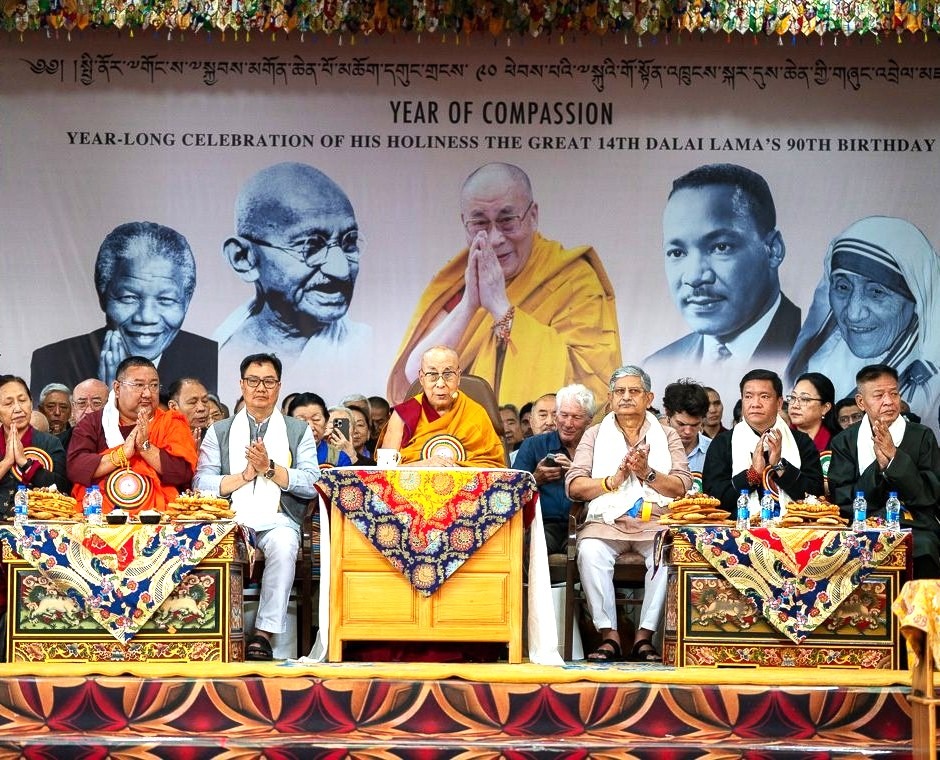
Panel of guests during the birthday celebration for His Holiness the Dalai Lama at the Main Temple, Dharamsala, July 6, 2025. Photo by Tenzin Choejar, courtesy of OHHDL.
Our August 2025 e-News is now available and brings many causes for rejoicing including:
- Teachings from Lama Zopa Rinpoche and Lama Yeshe
- Support offered to eight schools in India and Nepal
- Resources and opportunities for study and practice
- Information about an upcoming trek to Lawudo
- New opportunities to offer service in the FPMT organization
- News and stories from the FPMT community
And much more!
Please read this month’s e-news in its entirety.
Have the e-News translated into your native language by using our convenient translation facility located on the right-hand side of the page.
Visit our subscribe page to receive the FPMT International Office News directly in your email inbox.
- Tagged: fpmt enews
12
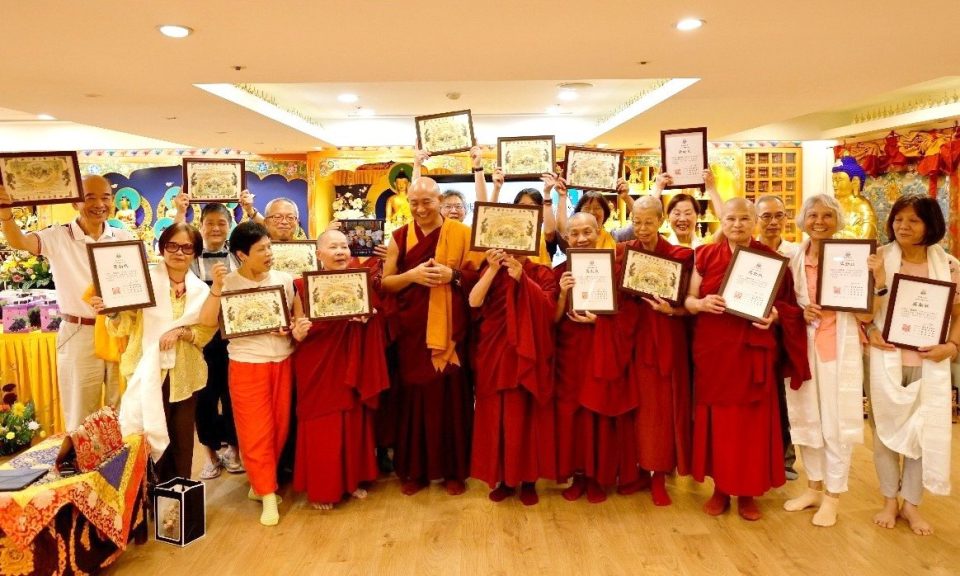
Geshe Jampa Sonam (center) with recipients of the Ornament certificate. Photo courtesy of Jinsiu Farlin.
On June 25, 2025, eleven students at Jinsiu Farlin, the Taiwanese FPMT center based in Taipei, completed 16 years of study of Ornament for Clear Realization, an FPMT Masters Program text. To honor this remarkable achievement FPMT Education Services issued a special bilingual certificate. Jinsiu Farlin Center Director, Ven. Thubten Osel, shares the story:
In 2009 Jinsiu Farlin embarked on an epic journey to offer the FPMT Masters Program subject of Ornament for Clear Realization in the form of a word commentary presented in weekly classes for an audience of 15-20 courageous students. This was an “epic” journey, because it became a series of 473 weekly classes offered over 16 years by three resident teachers: Geshe Thubten Gyurme (September 2009 to 2017), Khenrinpoche Geshe Tashi Tsethar (2017 to 2018) and Geshe Jampa Sonam (2018 to June 2025). Teacher Zhang (Zhang Fu Cheng), our translator, translated this class for 16 years!
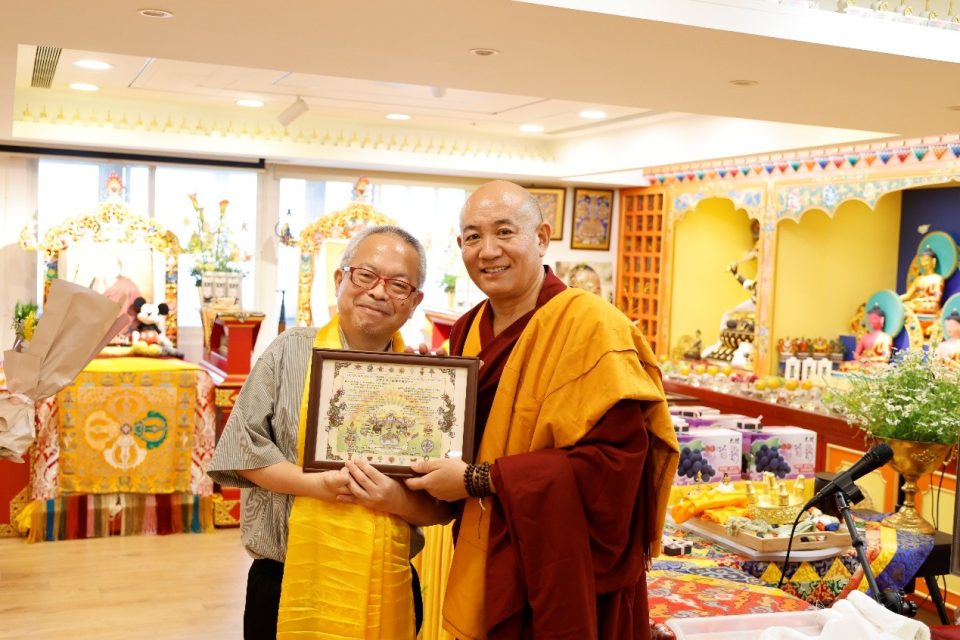
Teacher Zhang receiving a certificate from Geshe Jampa Sonam. Photo courtesy of Jinsiu Farlin
On June 25 we concluded the series of teachings with a certification ceremony. Eleven students received a completion certificate provided for this occasion by FPMT Education Services. Also honored with this certificate were the two staff members who had offered the hardworking service of providing meals and supporting the students in their study. An additional nine students who took the class in recent years received a participation certificate of encouragement offered by the center.
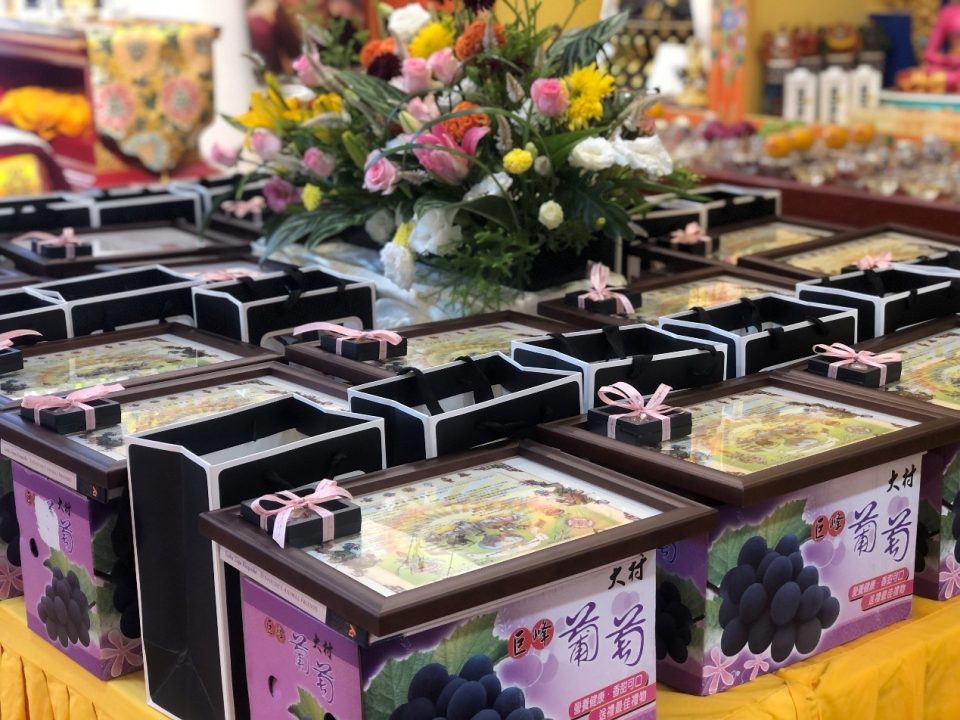
The framed certificate with gifts. Photo courtesy of Jinsiu Farlin.
The ceremony went very well! Each student received abundant gifts such as a box of grapes from a member’s grape farm, a copy of Lama Zopa Rinpoche’s recently released Rinpoche’s Animal Friends book, a bouquet of flowers, a brooch, and a khata from the center. Resident teacher Geshe Jampa Sonam handed out the certificates.
As a highlight of the ceremony we requested Gaden Trisur Rinpoche Lobsang Tenzin to bestow the oral transmission (via livestream) on the root text of Ornament for Clear Realization, and he kindly agreed. During that day we had more than 60 participants who came to attend the oral transmission in the center, and nearly 1,000 people around the world received the oral transmission online. We also requested the previous teachers of Ornament, Khenrinpoche Geshe Tashi Tsethar and Geshe Thubten Gyurme, to give advice to the students on this special day. Both teachers sent us their short video clips which were played for all participants. It was truly a special day filled with joy and gratitude.
Grateful thanks to Ven. Thubten Osel for sharing details and photos of this wonderful accomplishment and event! We welcome the submission of news stories from those within the FPMT community. This can be a story about something you have personally completed or accomplished, about someone else who has done so, or about the FPMT center, project, or service of which you are a part. Ideal submissions will give readers reasons to rejoice, share ideas, and create connections between those in the international community. Have something to share? Please let us know!
Foundation for the Preservation of Mahayana Tradition (FPMT), is a Tibetan Buddhist organization dedicated to the transmission of the Mahayana Buddhist tradition and values worldwide through teaching, meditation and community service.
1
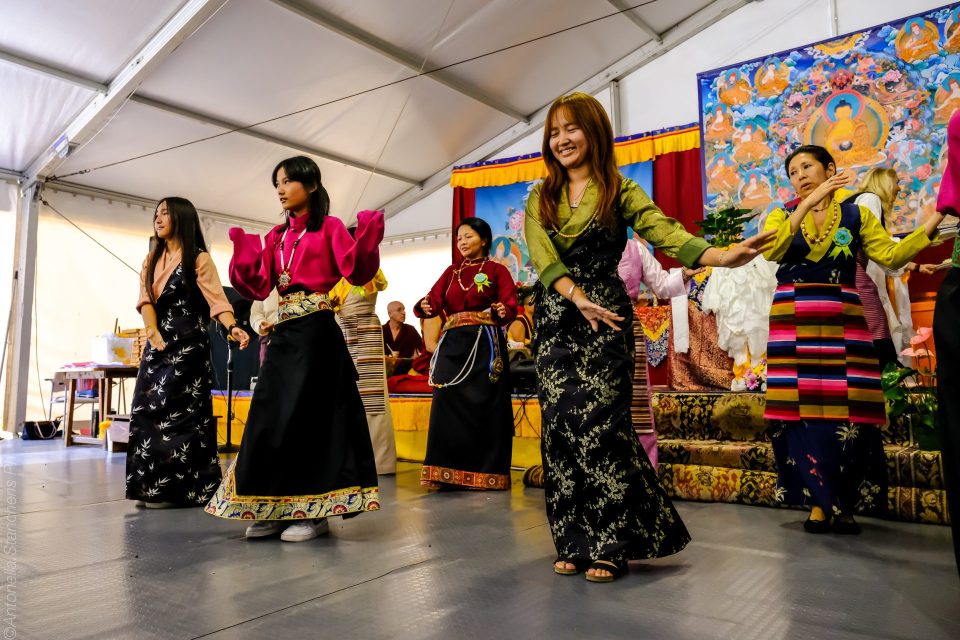
Association of Tibetan Women engaging in traditional dance. Photo courtesy of ILTK.
Recently Istituto Lama Tzong Khapa (ILTK) hosted community events centered around the celebration of His Holiness the Dalai Lama’s 90th birthday and the Year of Compassion, and in observance of Chokhor Duchen. Carlota Pinheiro and Fabiana Lotito share details of these events for great inspiration and rejoicing:
Lama Yeshe dreamed of ILTK as being something beautiful—a sacred space where people could walk the complete gradual path to enlightenment. Following Lama’s advice, the heart of everything we do here is simple: service.
Celebrating His Holiness’s 90th Birthday with the Italian Tibetan Community,
July 5-6 2025
It is fantastic to witness how the community keeps its cultural identity so intact, and how much they are willing to share it with us. After all, we owe the access to these life-changing teachings to the Tibetan people, and this is also a way of showing them gratitude.
The amount of young people that joined the 90th birthday celebration for His Holiness the Dalai Lama was astonishing. Their presence reflects not only how well the traditions are being passed down but how much hope there is for the future of the culture. The universal nature of this celebration is truly remarkable. Two full days in which everyone comes together to honor one thing only: the heart knows no borders.
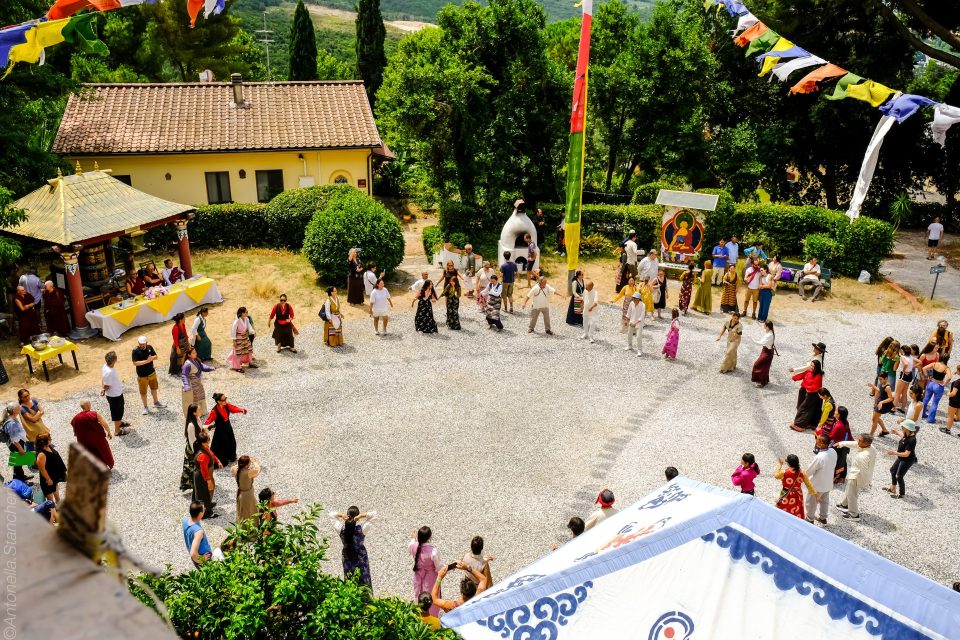
Gathering in the ILTK courtyard, July 5, 2025. Photo courtesy of ILTK.
On Saturday, July 5, more than 70 Tibetans started to gather around the courtyard of ILTK as we began the celebration. ILTK invited the Tibetan Community in Italy to come together to honor the person that brings us all together with his wonderful teachings on compassion. As the sun rose higher, so did the colors of our gardens, with colorful chubas and kids running around. This weekend means a lot not only to Buddhists, but to the whole world: celebrating the human values of love and kindness we all have within, through celebrating the person who makes it all possible—His Holiness the Dalai Lama. The weekend was a beautiful reminder of how his teachings make the world a better place and life easier to live, even in the hardest of times.
Day One: Voice for the Voiceless
On Saturday July 5 we started with something new called our Book Club of Compassion where we dive into one of His Holiness’s books each month. Everyone gathers in the coffee shop to chat about what they’ve read and share their insights and stories. Guided by Fiorella Rizzi, this is an initiative ILTK is doing to celebrate the Year of Compassion on the occasion of His Holiness’s 90th birthday celebration.
His Holiness’s new book, Voice for the Voiceless, is a profound collection of speeches, statements, and writings on the Tibetan people’s struggle under Chinese rule, their aspirations for peace; and the importance of human rights, nonviolence, and compassion. After discussing it in the book club, the opportunity and occasion was perfect to present it, surrounded by Tibetans, some of whom lived his words firsthand.
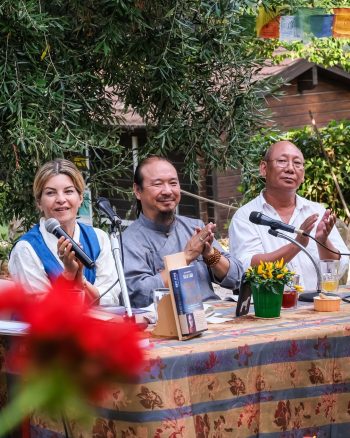
Discussing His Holiness’s new book, Voice of the Voiceless at ILTK. Photo courtesy of ILTK.
Geshe Gelek and Geshe Thenpel, the resident teachers of ILTK, sat in the tea garden, together with the president of ILTK, Lucia Landi; Marco Ventura, a university professor of “rights and religion;” the Vice President of the Tibetan community in Italy, Nyima Dhondrup; and a special guest, Sangjey Kep, the Chinese Liaison Officer for Europe in Geneva. They discussed, among many things, the importance of speaking up about the Tibetan cause every time we have the opportunity, about human rights and religious freedom, and how this matter goes much beyond politics. Sangjey Kep said, “China is not the enemy. It is the Guru.” One of the most inspiring phrases of His Holiness: “These are the teachings we need to put into practice.”
Grateful for this open discussion about such an important topic, we moved to the big tent where members of the Tibetan community gifted everyone with opera, group songs, and beautiful traditional dances.
Day Two: Songs of Home
On Sunday July 6, the Tibetans rose early to prepare the long life puja for His Holiness. The traditional laid-back and devotional atmosphere made everyone feel at home. At the end of the prayers, we rose to sing the Tibetan national anthem. The pain and love, loss and compassion was felt in everyone’s voices. It is such a united people—even though spread across the world, their home is now their community. It was a true honor to witness this celebration unfolding.

Geshe Tenzin Tenphel with the ILTK President Lucia Landi and , Sangjey Kep, the Chinese Liaison Officer for Europe, cutting cake. Photo courtesy of ILTK.
Happy Birthday was sung in three languages by a group of young Tibetan girls and the big cake was cut and distributed to all. Such a joy! We gathered again in the courtyard where ILTK’s group of workers and volunteers presented three Tibetan dances they have been practicing for months. With traditional dresses and braids and a shared love and honor for the culture, there was no distinguishing between the East and the West in this moment, everyone joined the circle and we danced in joy and laughed together with the geshes seated at the table of the puja.
Massimo Corona, co-founder and former director of ILTK, gifted us with a wonderful Q&A session in the gompa where he opened up his treasure chest of memories about His Holiness, sharing stories that sparkled with warmth—from that very first meeting all the way through His Holiness’s many visits to ILTK over the years. People asked questions, both in the gompa and following us online, all curious about what makes this figure so unique and important in our world. There was something special about listening to Massimo speak—it felt like all of of His Holiness’s teachings were somehow present in that room, woven into every story and response.
Celebrating Chokor Duchen and the International Sangha Day
On July 28 we gathered to celebrate the Sangha by inviting two monastics to tea in our tea garden, blessed with the statues of both Lama Yeshe and Geshe Jampa Gyatso (former resident teacher at ILTK).
Every month, we offer open sessions, “At the Tea Garden to Answer Your Whys” with members of the Sangha to answer questions of anyone who wishes to come. This is an initiative to create awareness, inspiration, and an effort to be accessible and inclusive to all. People came from cities across Tuscany—some for the first time—to gather in an informal setting where Dharma becomes accessible in the most relaxed way.
Since on this special we also celebrated Chokor Duchen, Ven. Raffaello opened the session with a wonderful introduction to the First Turning of the Wheel of Dharma. He told the story of Siddhartha leaving his palace to encounter the four types of suffering, and how that led to his ascetic practices and later to his enlightenment. The Buddha’s first teaching was about the Four Noble Truths, at Deer Park in Sarnath, India. This being the foundation of all Buddhist philosophy, made this occasion at the tea garden very special, where a lot of new people had the opportunity to listen to the foundations of what truly brings us together: the recognition of suffering and the wish to free all beings from it.
Afterward, people wrote their questions on small papers that Ven. Carla Tzultrim and Ven, Raffaello drew from a box, reading and responding to each one aloud. This time, the theme was “emotions.” Two nurses shared how vital these insights are for their work and how much they appreciate finding another way to ease their suffering and discover answers to their questions—something that isn’t a formal talk or retreat they can’t attend because of their demanding jobs. It was deeply inspiring to watch people of all ages come open-heartedly to sit on the grass and listen to ordained practitioners speaking directly to our hearts, as if they understood exactly what kind of suffering we each carry.
Lama Yeshe’s Legacy

Lama Yeshe at Istituto Lama Tzong Khapa, Italy, 1983. Photo courtesy Lama Yeshe Wisdom Archive, donated by Merry Colony.
Life here at ILTK has this wonderful rhythm to it—always something happening, always new faces appearing. We love seeing fresh people join our monthly pujas, and beyond our daily meditations, volunteers gather each week for Dharma Talks. For many, these talks become their first real taste of the Dharma, which feels pretty special.
Lama Yeshe used to remind us that ILTK should serve the community and be a refuge for everyone. That spirit still guides everything we do here. As he taught, we build this mandala by offering our body, speech, and mind to others. When we’re lucky enough to encounter Buddha’s Mahayana Dharma, we naturally want to share that gift with others. He called for harmony, mutual respect, and open hearts among all members, regardless of cultural differences, united in the common goal of guiding others toward enlightenment. We are deeply grateful for the opportunity of serving, providing these spaces and welcoming everyone!
With grateful thanks to Carlota Pinheiro and Fabiana Lotito for sharing this inspiring report on recent activities at ILTK. We welcome the submission of news stories from those within the FPMT community. This can be a story about something you have personally completed or accomplished, about someone else who has done so, or about the FPMT center, project, or service of which you are a part. Ideal submissions will give readers reasons to rejoice, share ideas, and create connections between those in the international community. Have something to share? Please let us know!
Foundation for the Preservation of Mahayana Tradition (FPMT), is a Tibetan Buddhist organization dedicated to the transmission of the Mahayana Buddhist tradition and values worldwide through teaching, meditation and community service.
30
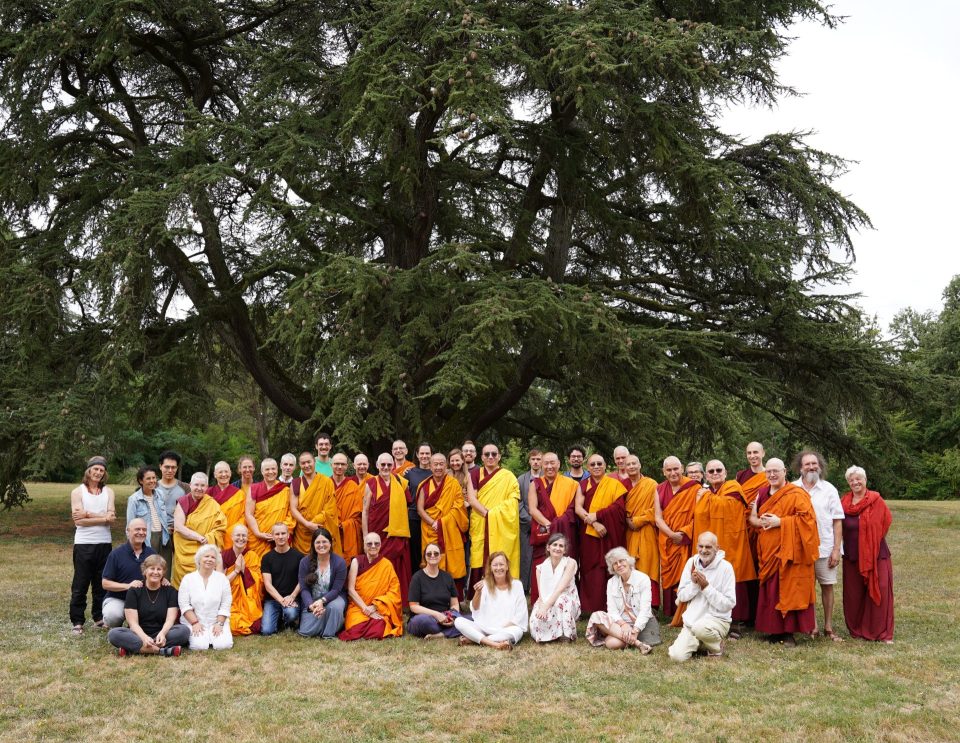
Participants in the Most Secret Hayagriva Retreat at Nalanda Monastery, July 2025. Photo by Sonam Sherpa.
A very rare opportunity of a two-week Most Secret Hayagriva Retreat occurred on grounds of Nalanda Monastery from July 11-28, 2025. One participant described this retreat as an, “incredibly blessed dimension.”
Hayagriva is the wrathful manifestation of Chenrezig, the Buddha of Compassion. The practice of Most Secret Hayagriva is extremely powerful to grant help and support and to quickly pacify obstacles. Both Lama Yeshe and Lama Zopa Rinpoche had a special connection to the Most Secret Hayagriva. As Ven. Roger Kunsang, who participated in the retreat explained, “The Most Secret Hayagriva retreat is the practice/commitment that Lama Yeshe gave to Lama Zopa Rinpoche to do every year for the protection and success of the entire FPMT organization. And now this is a commitment the whole organization is taking on.”
Nalandala Monastery shared the following report of this most auspicious and powerful retreat, please rejoice!
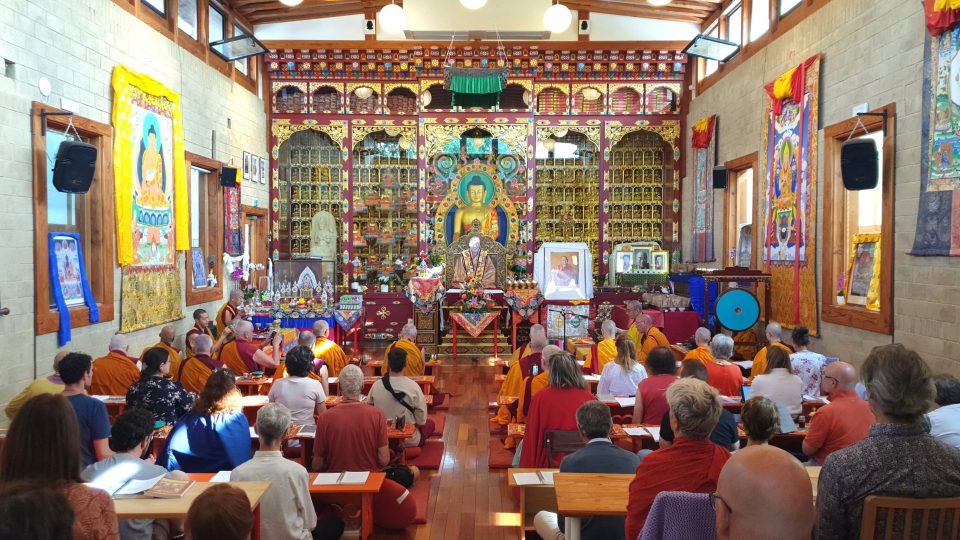
Most Secret Hayagriva Retreat at Nalanda Monastery, Kul 2025. Photo by Sonam Sherpa.
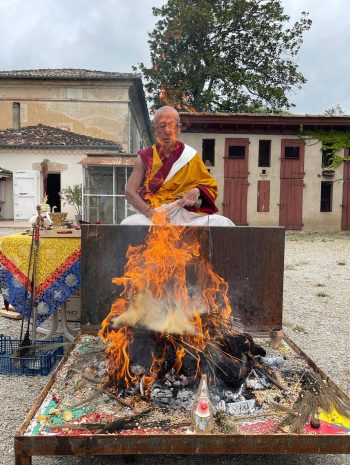
Hayagriva fire puja at Nalanda, July 27, 2025. Photo courtesy of Nalanda Monastery.
From July 11-28, 39 people participated in the Most Secret Hayagriva retreat at Nalanda Monastery lead by Geshe Thubten Sonam with the support of Genden Dargey, the main chant leader of Sera Jey Monastery, Geshe Dorjee Wangdak, Geshe Tashi Dondup, who made all the numerous traditional tormas, and Geshe Gyaltsen, one of our resident teacher. It was a very rare opportunity, as many conditions were needed to perform such an incredibly profound and ancient meditation for two weeks.
Connecting with this lineage kept unbroken from the Buddha and practiced by such realized holy beings such as Nagarjuna, Guru Rinpoche, etc. up to Sera Jey in South India nowadays, each participant felt something very special. Some had deep spiritual experiences.
”The retreat has been extraordinary. Some who already did previous deities retreats said that it is exceptional, very rare, to have such a quality, without any fault from beginning to end,” one participant shared.
We concluded the retreat with such a smooth and blessed fire puja. The next day, for Chokhor Duchen we made an extensive tsog offering to Hayagriva. Next time, Geshe Thubten Sonam will lead a shorter retreat and will give some explanations. May this happen!
Please watch a short video clip of the fire puja:
Story submitted by Nalanda Monastery. Please read more about the practice of Hayagriva and its connection to the FPMT organization.
We welcome the submission of news stories from those within the FPMT community. This can be a story about something you have personally completed or accomplished, about someone else who has done so, or about the FPMT center, project, or service of which you are a part. Ideal submissions will give readers reasons to rejoice, share ideas, and create connections between those in the international community. Have something to share? Please let us know!
Foundation for the Preservation of Mahayana Tradition (FPMT), is a Tibetan Buddhist organization dedicated to the transmission of the Mahayana Buddhist tradition and values worldwide through teaching, meditation and community service.
- Tagged: hayagriva, most secret hayagriva, nalanda monastery
27
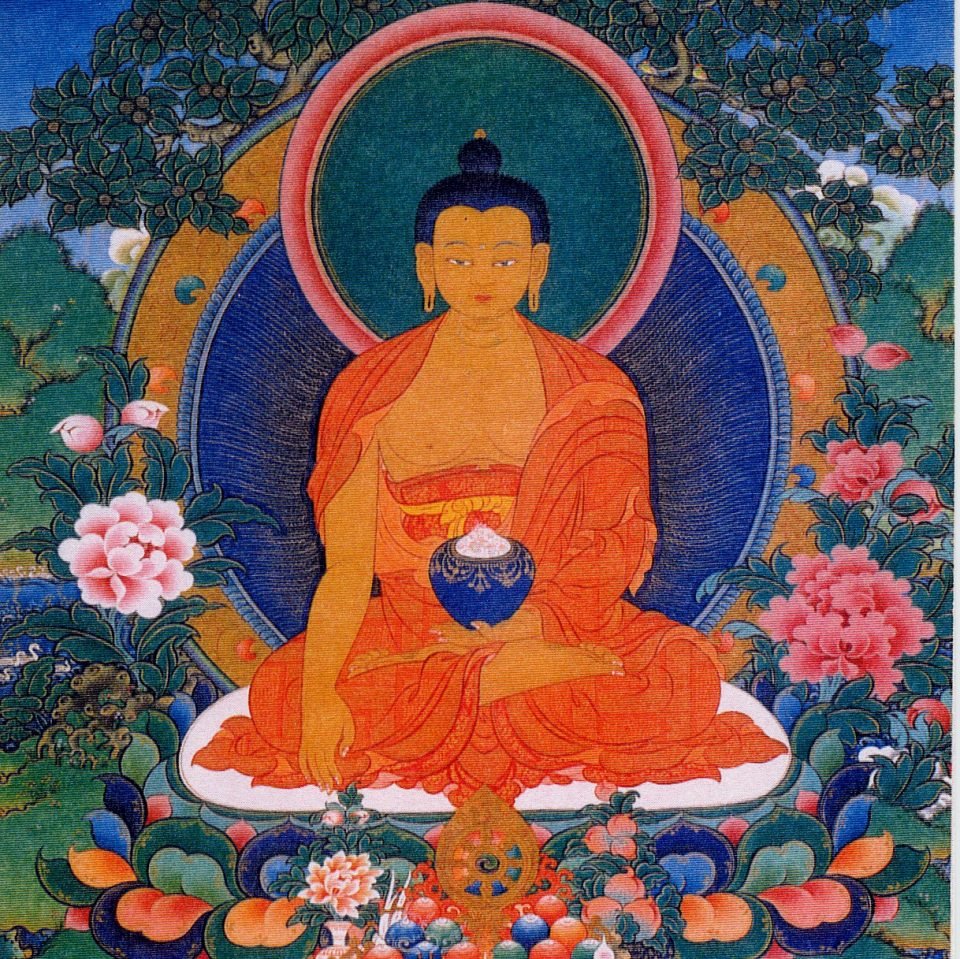
Shakyamuni Buddha
Chokhor Duchen, one of the four annual holy days of Guru Shakyamuni Buddha, and FPMT International Sangha Day both take place this year on July 28.
Please read about this special “Turning the Wheel of Dharma” merit-multiplying day, access all of Lama Zopa Rinpoche’s advice for auspicious activities and practices to do to maximize the opportunity, as well as inspiration for celebrating International Sangha Day.
Please also read about and rejoice in the various pujas and practices being sponsored and arranged on behalf of the entire FPMT organization, dedicated for the benefit of the whole FPMT organization and all beings.
Foundation for the Preservation of Mahayana Tradition (FPMT), is a Tibetan Buddhist organization dedicated to the transmission of the Mahayana Buddhist tradition and values worldwide through teaching, meditation and community service.
- Tagged: chokhor duchen
25
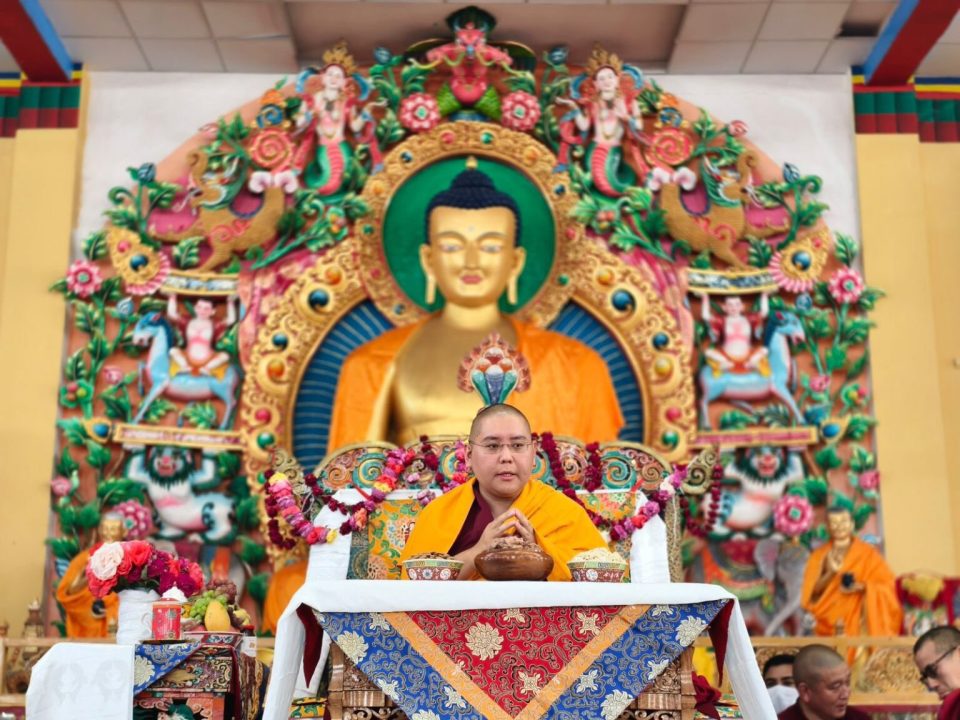
H.E. Kyabje Ling Rinpoche giving teachings in Choglamsar, Ladakh, India, June 23, 2025. Photo from Ling Rinpoche’s official website.
FPMT centers around the world provide students with truly precious opportunities to connect with qualified high lamas. We want to share some upcoming opportunities to attend teachings and initiations in FPMT centers with high lamas such as His Eminence Kyabje Yongzin Ling Rinpoche, His Eminence Khensur Jhado Tulku Rinpoche, and Serkong Tsenshab Rinpoche. Many of these opportunities are available online, or with hybrid opportunities, so please do check details on each.
His Eminence Kyabje Yongzin Ling Rinpoche will be offering a teaching on the Foundation for All Good Qualities, an oral transmission of Chanting the Names of Majushri, and a Vajrasattva Initiation at Hayagriva Centre, Australia on July 26 and 27.
While in Australia he will also offer White Tara and Medicine Buddha initiations and a teaching on The Three Principal Aspects of the Path on August 3-4 at Vajrayana Centre, a Green Tara initiation on August 12 at Tara Institute, and Buddha Amitayus and Twenty-One Taras initiations and a public teaching at the Great Stupa of Universal Compassion August 16-17.
You can see His Eminence’s full schedule for additional opportunities at other non=FPMT centers as well.
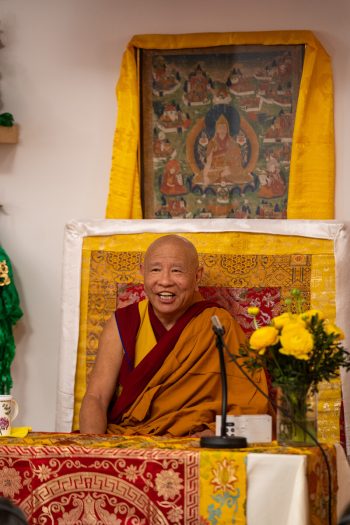
H.E. Jhado Rinpoche giving a teaching at Arya Tara Institute, Munich, Germany, March 23, 2023. Photo by Harald Weichhart.
His Eminence Khensur Jhado Tulku Rinpoche is visiting FPMT centers in Australia and New Zealand in the coming months. Rinpoche will start his tour at Vajrayana Institute, Australia by giving teachings on Key of the Middle Way by H.H. Dalai Lama and offering a Vajrasattva Initiation on August 29-31, 2025.
At Chenrezig Institute in Australia he will give teachings on In Praise of Dependent Origination and The Three Principal Aspects of the Path on September 4 and empowerments of the three main deities within the Gelug tradition: Vajrayana Guhyasamaja, Chakrasamvara, and Yamantaka on September 5-9.
On September 14-15 Rinpoche will give Kalachakra initiation at the Great Stupa of Universal Compassion in Australia. He will also give introductory teachings at the beginning of the Kalachakra Retreat for World Peace (September 15 – October 19, 2025) and lead the fire puja at the end of retreat.
On October 3-15, 2025 Jhado Rinpoche will give teachings on The Foundation of All Good Qualities, Most Secret Hayagriva Initiation and oral transmission of Most Secret Hayagriva texts, Chittamani Tara Highest Yoga Tantra Initiation and oral transmission and commentary to Chittamani Tara practice as well as Long-life Initiation of Je Rinpoche Lama Tsong Khapa at Chandrakirti Meditation Centre in New Zealand.
You can follow Jhado Rinpoche’s social media to learn about additional opportunities to connect with him at other centers.
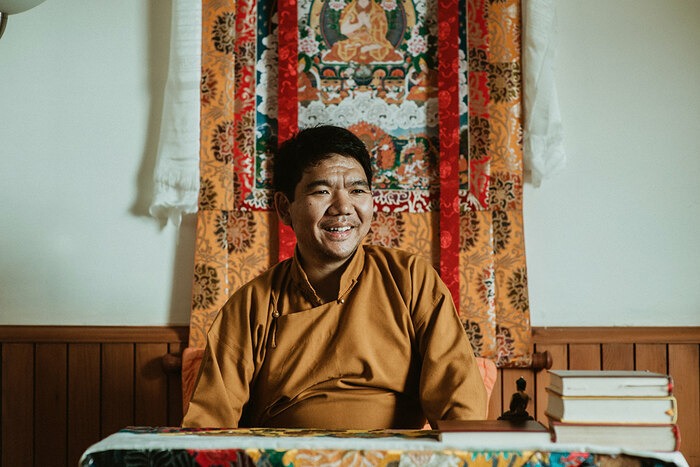
Serkong Rinpoche at his home in McLeod Ganj, northern India, 2018. Photo from Study Buddhism website.
Serkong Tsenshab Rinpoche will lead Cultivating Compassion in Daily Life weekend retreat at Vajrapani Institute, USA on August 15-17. At Land of Medicine Buddha, USA on August 18 – 24, 2025 he will lead a weeklong retreat Path to True Freedom that will focus on the Special Insight chapter from Lamrim Chenmo. Rinpoche will kindly offer evening teachings on the same subject to those who cannot join the retreat on August 18 – 23, 2025. In September, Rinpoche will offer a teaching on Guide to the Bodhisattva’s Way of Life and offer an oral transmission of Chanting the Names of Manjushri at Shantideva Center, New York, from September 19-21; and also at Tibet House in New York, co-hosted by Shantideva Center, Rinpoche will offer a teaching on Emptiness, Relativity and Interdependence on September 30. Rinpoche also will be visiting Wisdom Publications in New York during this time for a Dharma Chat episode. On January 14-19, 2026 Serkong Tsenshab Rinpoche will lead a course on Song of the Four Mindfulnesses at Root Institute in India.
We hope that students will be able to take advantage of some of these most precious opportunities that are upcoming over the next few months in FPMT centers.
Foundation for the Preservation of Mahayana Tradition (FPMT), is a Tibetan Buddhist organization dedicated to the transmission of the Mahayana Buddhist tradition and values worldwide through teaching, meditation and community service.
23

Panel of guests during the birthday celebration for His Holiness the Dalai Lama at the Main Temple, Dharamsala, July 6, 2025. Photo by Tenzin Choejor, courtesy of OHHDL.
On July 5 and 6, 2025, two powerful events occurred in McLeod Ganj, Dharamsala, in celebration of His Holiness the Dalai Lama’s 90th birthday, and with strong prayers for His Holiness to remain among us for a very long time. These events also kicked off the start of “the year of compassion” which will be a year long celebration of His Holiness’s many compassionate activities and qualities.
FPMT South Asia Regional Coordinator, Frances Howland, attended and participated in the long-life puja of July 5 where the offering of 100 statues of Shakyamuni Buddha on behalf of the entire FPMT organization occurred, and attended the birthday celebrations on July 6. Please read her heartfelt report of the events and enjoy these joyful photos!
Celebrating the 90th Birthday of His Holiness the Great 14th Dalai Lama in McLeod Ganj
By Frances Howland
McLeod Ganj, rain-soaked and bustling, held a series of joyful and deeply moving celebrations to mark the 90th birthday of His Holiness the Fourteenth Dalai Lama, and marking the beginning of the ‘Year of Compassion.’ The festivities took place at the main temple (Tsuglagkhang) and surrounding areas, bringing together monastics from all traditions, dignitaries, Buddhist practitioners, media, and friends of Tibet from all over the world.
The celebrations were part of a week-long festival held across this hill station, where the vibrant atmosphere reflected the deep love, gratitude, and respect people hold for His Holiness—whose life has been a beacon of compassion, wisdom, and tireless service to others.
July 5 was the offering of a long-life prayer ceremony by the Tibetan Government and representatives of the major Tibetan Buddhist traditions. In the elaborately decorated temple courtyard, there were photographs of His Holiness at different stages of his life, as well as peace champions—Nelson Mandela, Mahatma Gandhi, Martin Luther King Jr., and Mother Teresa.
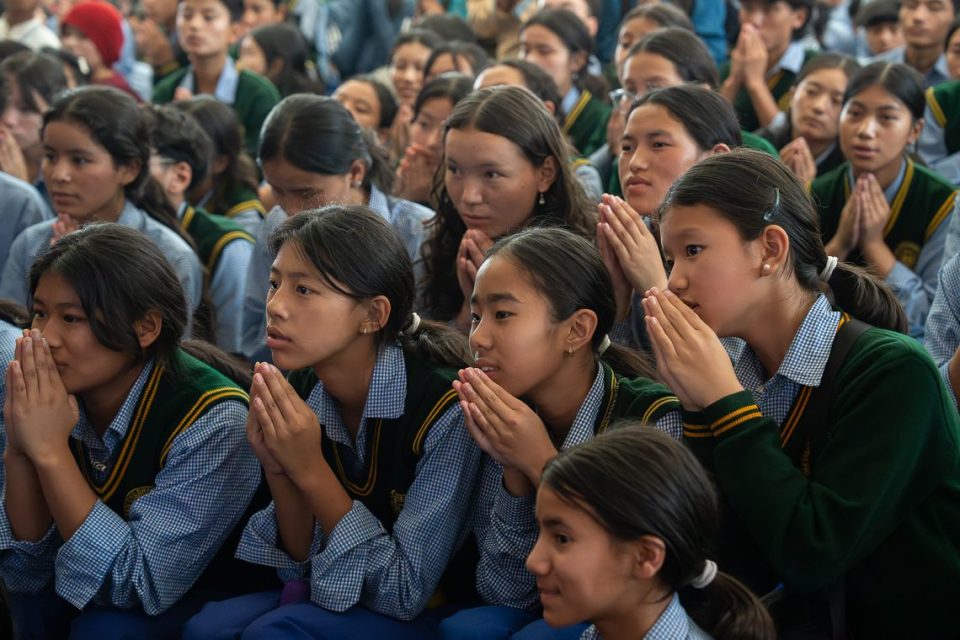
Tibetan students watching His Holiness the Dalai Lama during the long-life prayer ceremony, July 5, 2025 Photo by Tenzin Choejor, courtesy of OHHDL.
It commenced with a rare appearance of five of the State Oracles, each approaching His Holiness in trance, making offerings and throwing handfuls of colored grain:
- Tsering Chenga (Khandro Tseringma Rinpoche) is the State Medium of the Twelve Tenma Goddesses, guardians of Tibet and protectors of the Dharma.
- Kharak Khyung Tsün is one of the Twelve Tenma Goddesses, she is specifically invoked during ceremonies, including long-life offerings for His Holiness.
- The Nechung Oracle is the medium for the powerful deity Pehar, who offers guidance on important matters, particularly those concerning the Dalai Lama and Tibetan state affairs. He presented the sacred offerings directly to His Holiness and then saluted the chief Lamas and leading members of the Tibetan Government.
- Dorjé Yudrönma is a protector deity, also one of the Twelve Tenma Goddesses, who are female deities of Tibet. She danced energetically in trance before offering blessings.
- Nyenchen Tanglha is a mountain deity and protector and is considered the ancestor of Tibetan kings.
Meanwhile, in the lower courtyard, two women entered trance states spontaneously amidst the tightly packed crowd.
The spiritual leaders of Tibet’s principal Buddhist traditions—as well as the Bönpos and Jonangpas—came forward to pay their respects, followed by a steady procession of members of the Tibetan government from India and abroad. They carried offerings—sacred images, scriptures, and so forth—to be presented to His Holiness.
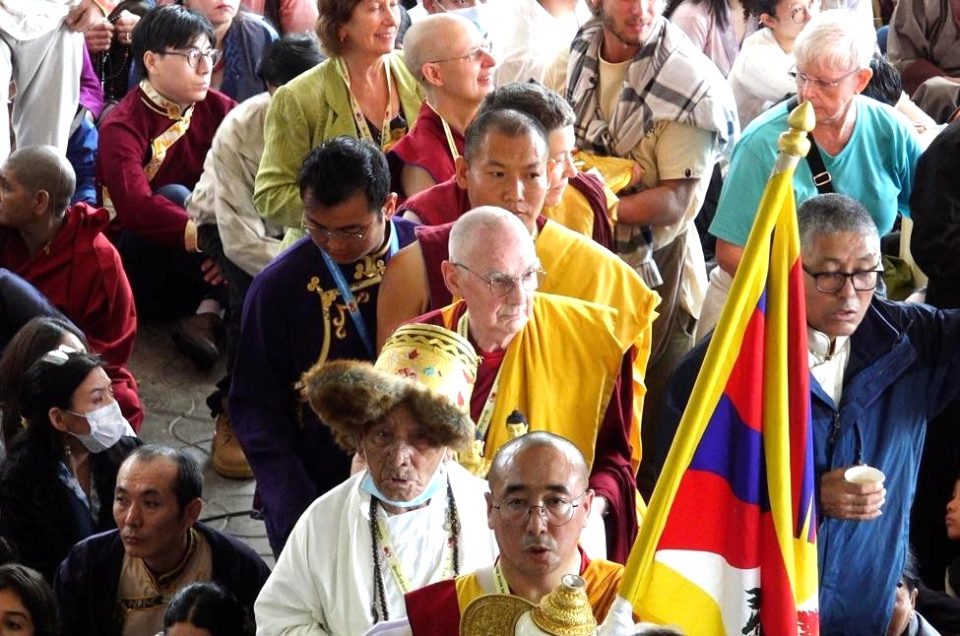
Ven. Roger Kunsang Ven. Topgye, Ven. Elisabeth Drukier Ven. Kunphen, and Frances Howland in procession during the long life puja for His Holiness the Dalai Lama, July 5, 2025.
I was the final person in the procession, number 143. Ahead of me were Ven. Roger Kunsang, FPMT CEO, Ven. Topgye from Kopan Monastery, Ven. Elisabeth Drukier from Kalachakra Centre in Paris, and Ven. Kunphen from Tushita Dharamsala. FPMT had been honored with five places in the procession to offer a few of the 100 beautiful golden Shakyamuni Buddha statues.
His Holiness then addressed the congregation:
“Here today we have representatives of gods and human beings gathering for the auspicious circumstances for my long life, making your prayers intensely and sincerely. On my part, it is clear that I have a connection to Avalokiteshvara. Ever since I was a child, I’ve felt I had this connection and I have been able to serve the Buddha Dharma and the beings of Tibet. I still hope to live to be more than 130 years old.”
His Holiness left the temple saluting the guests and, as he walked to the lift, smiled and waved to the crowd.
July 6 was the official birthday of His Holiness. Rain poured down as we all arrived at the celebration. The red carpet leading through the courtyard was lined with baskets of lilies, while photographers and cameramen jostled for position.
The event began with various musical groups and dancers. Some played traditional Tibetan instruments, while others performed with drums and bagpipes. As they sang in Tibetan, the common wish was: “May His Holiness live long and continue to teach from his firmly established throne.”
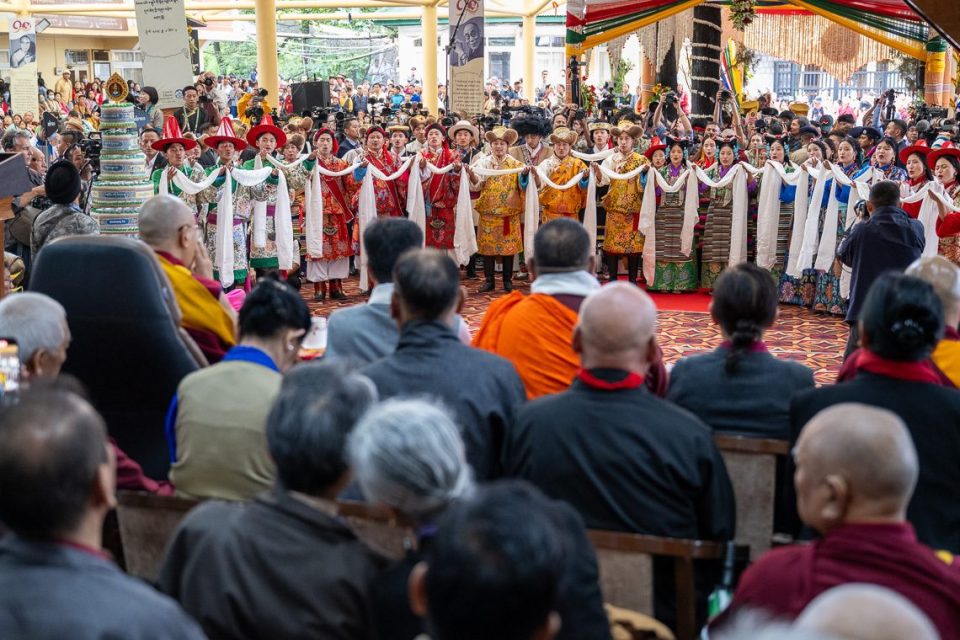
Artists from the Tibetan Institute of Performing Arts singing happy birthday to His Holiness, July 6, 2025. Photo by Zamling Norbu, courtesy of OHHDL.
A Tuvan group performed traditional throat singing, while a young contortionist in a sparkling gold outfit drew gasps from the audience with her astonishing movements.
His Holiness addressed the gathering:
“Today, my dear friends, you are celebrating my 90th birthday. You have gathered here with joy in your hearts.”
The Sikyong (leader of the government in exile) introduced the many honored guests, including heads of major monasteries, Indian State Ministers, foreign embassies, and international representatives—including Richard Gere. Each delivered messages highlighting the Dalai Lama’s immeasurable contributions to peace, nonviolence, interfaith harmony, and the preservation of Tibetan culture and identity.
Three former US Presidents—Bill Clinton, Barack Obama, and George W. Bush—had recorded brief video messages, which were played on the big screens, followed by a message from the President of Taiwan.
More celebratory songs followed in Hindi and English. A Chinese artist presented a work of art, and the Speaker of the Parliament released a new biography of the Great Fourteenth Dalai Lama.
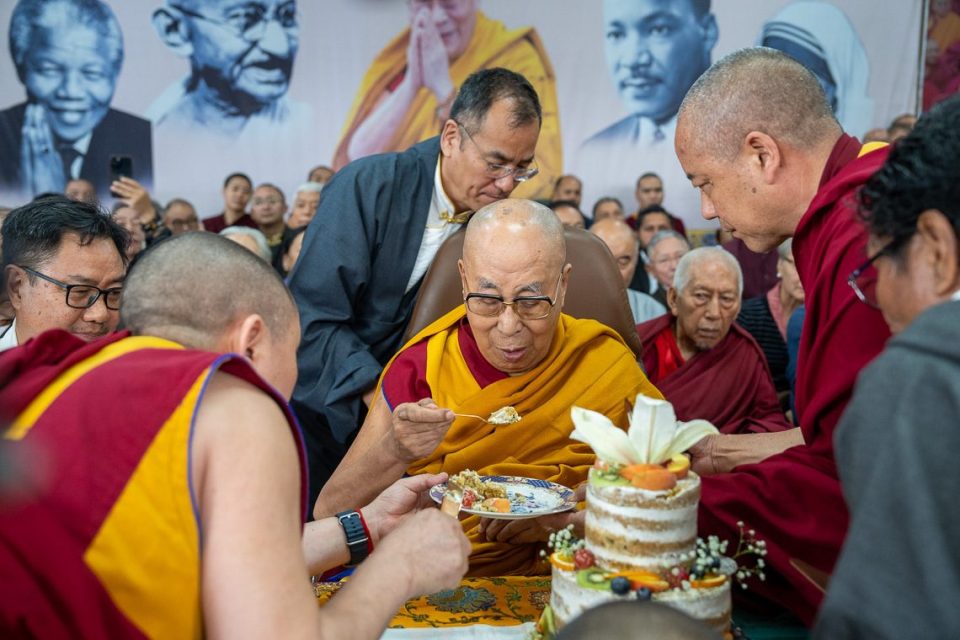
His Holiness the Dalai Lama trying the first bite of his birthday cake, July 6, 2025. Photo by Tenzin Choejor, courtesy of OHHDL.
A towering nine-tier birthday cake was cut, and His Holiness ate the first piece, while the rest was distributed among the gathered crowd. His Holiness then left the event to the sound of “Happy Birthday” being sung very loudly by a Taiwanese group.
Celebrations took place across the world and FPMT’s Tushita Meditation Centre, 35 minutes’ walk up the hill from His Holiness, was no exception. In the afternoon they organized a celebratory event including a film screening of Until Space Remains by Gaurav Saxena.
The gompa was filled with students and visitors joining in the long-life prayers and offering katas to His Holiness’ throne. Ven. Roger Kunsang praised His Holiness’ qualities and shared stories about His Holiness, Geshe Sopa, and Kyabje Lama Zopa Rinpoche. Also present were Geshema Kelsang Wangmo from Germany, who was leading the Tushita annual advanced course, and Ven. Thubten Dekyong (Anila Tsenla), who was responsible for the establishment of the Kopan Nunnery. Happy Birthday was sung in English, Tibetan, Hindi, Hebrew, German, Spanish, French, Italian, Greek, Polish, Russian, and Chinese.
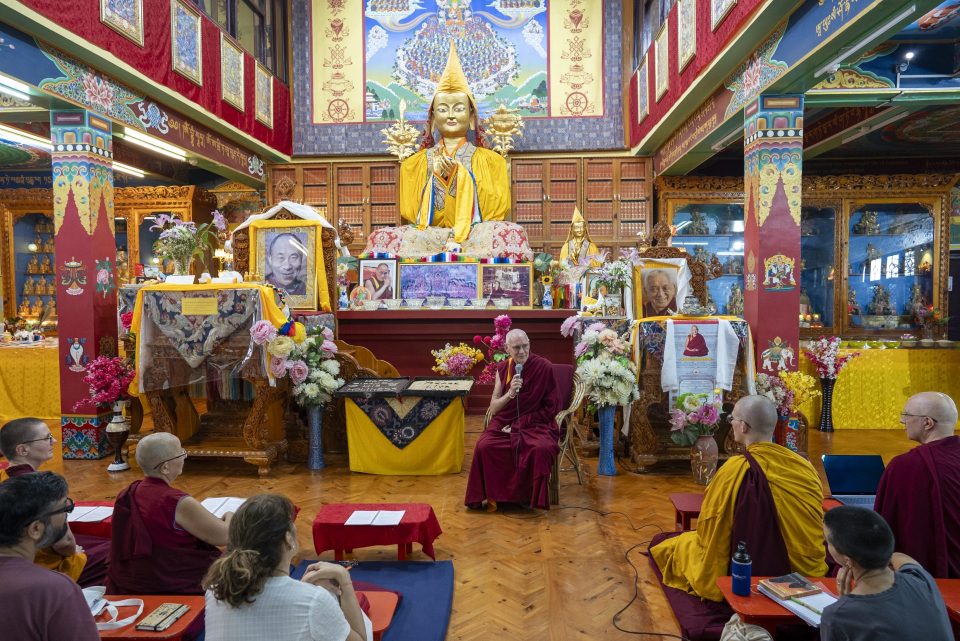
Ven. Roger Kunsang addressing participants in the celebrations for His Holiness’s 90th birthday at Tushita Meditation Centre, July 6, 2025. Photo courtesy of Tushita Meditation Centre.
With prayers for His Holiness’s long life echoing across the hills and hearts of all present, the 90th birthday celebration came to a close, leaving everyone inspired to continue His legacy of compassion in action.
Written by Frances Howland. Frances moved from Hong Kong, where she was a midwife, to New Delhi in 1984 to manage Tushita Mahayana Meditation Centre, succeeding Trisha Donnelley. In 1986, she became Director of the Himalayan Buddhist Meditation Centre in Kathmandu for ten years. She then served for five years on the FPMT Inc. Board of Directors. Frances has been the South Asia Regional Coordinator ever since and is now also Co-Director of Lawudo Retreat Centre, alongside Rinpoche’s sister, Anila Ngawang Samten. Throughout her time in Kathmandu, she has always worked as a nurse.
We invite you to also rejoice that Yeshin Norbu, the FPMT center in Stockholm, Sweden, organized the recitation of over 56 million Mani mantras which were offered to His Holiness, following their Mani Retreat Initiative, held with various FPMT centers and students around the world since last Losar. The following message was received from the Office of His Holiness: “I have been directed to thank all of you for your offering of 56 million Mani mantras for His Holiness the Dalai Lama on the occasion of his 90th birthday. I am happy to convey to you His Holiness prayers and good wishes.”
We recently published several stories about His Holiness the Dalai Lama, and we invite you to explore those as well.
Foundation for the Preservation of Mahayana Tradition (FPMT), is a Tibetan Buddhist organization dedicated to the transmission of the Mahayana Buddhist tradition and values worldwide through teaching, meditation and community service.
- Tagged: his holiness, his holiness the dalai lama
17
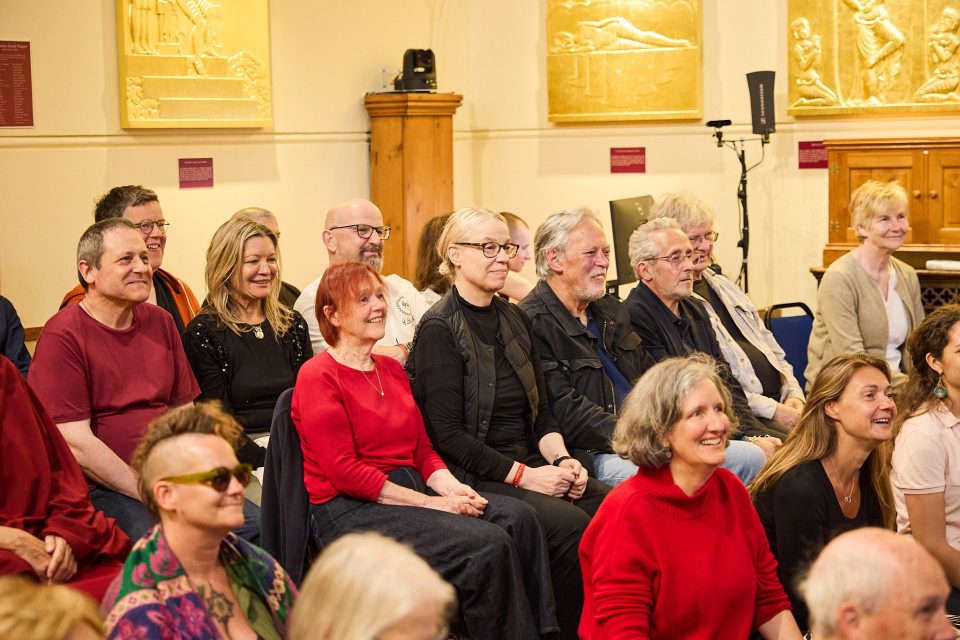
Participants in a community event at Jamyang London. Photo courtesy of Jamyang London.
By Paul Wells, Jamyang London Communications Manager
In a move that reflects the evolving needs of modern Dharma centers, FPMT’s Jamyang London has created a new People & Community Manager role. Like many spiritual organizations, we’ve seen that sustaining the Dharma depends as much on community and volunteer work as it does on teachers and teachings.
Like all FPMT centers, Jamyang’s primary mission is spiritual. The work of preserving and sharing the Buddha’s teachings, supporting sincere practitioners, and fulfilling the vast vision of our lineage masters is at the heart of everything. But over time, a secondary mission has emerged—one that makes the first mission possible. That is, the ability to host, care for, and organize a community of people who offer their time, skills, and service in the spirit of generosity.
Volunteers cook meals, sweep the gompa, water the garden, run the bookshop, and welcome new faces. They are the living infrastructure of the center. And yet, many organizations rely on ad hoc or overstretched and outdated systems to support them. Taking a conscious and vital step in a new direction, is one of the ways in which we can repay the kindness of those who offer service.
The People & Community Manager role is designed to give shape and care to this area of the center’s life. It will provide structure to the volunteer experience, ensure inclusion and accessibility, and offer clear pathways for people to connect and contribute meaningfully, which is ever more important as people lean in to offer service not just in the building, but remotely and digitally too. It’s a role that recognizes the power of relationship and the deep interdependence between those who serve and those who receive.
“As Dharma centers we often focus on the what —bringing the precious teachings to the community. But how we do this matters just as much. It’s where we apply our Dharma principles. That’s why creating the right conditions to support those who tirelessly offer service is so critical.” says Jamyang’s Executive Director, Ven. Thubten Drolma, “We feel enormously fortunate to be able to create a role dedicated to supporting the people who make everything possible.”
The creation of this role takes seriously the often-invisible work of holding community, and investing in the systems and people that make it thrive. This new role marks a hopeful step in recognizing the quiet systems that make spiritual community possible. It affirms the value of service, supports harmony and longevity, the need for thoughtful coordination, and the beauty of supporting one another with care and clarity. It’s a role that says: we see you, we value your service, and we want to do it better—for everyone.
Written by Paul Wells, Communications Manager for Jamyang London. Jamyang is very happy to offer more information about the development of their People & Community Manager role, should any FPMT center wish to pursue creating a position like this to suit their own community’s needs.
We welcome the submission of news stories from those within the FPMT community. This can be a story about something you have personally completed or accomplished, about someone else who has done so, or about the FPMT center, project, or service of which you are a part. Ideal submissions will give readers reasons to rejoice, share ideas, and create connections between those in the international community. Have something to share? Please let us know!
Foundation for the Preservation of Mahayana Tradition (FPMT), is a Tibetan Buddhist organization dedicated to the transmission of the Mahayana Buddhist tradition and values worldwide through teaching, meditation and community service.
- Tagged: jamyang london
14
Tara Lanka’s Pilgrimage to Sri Pada Mountain
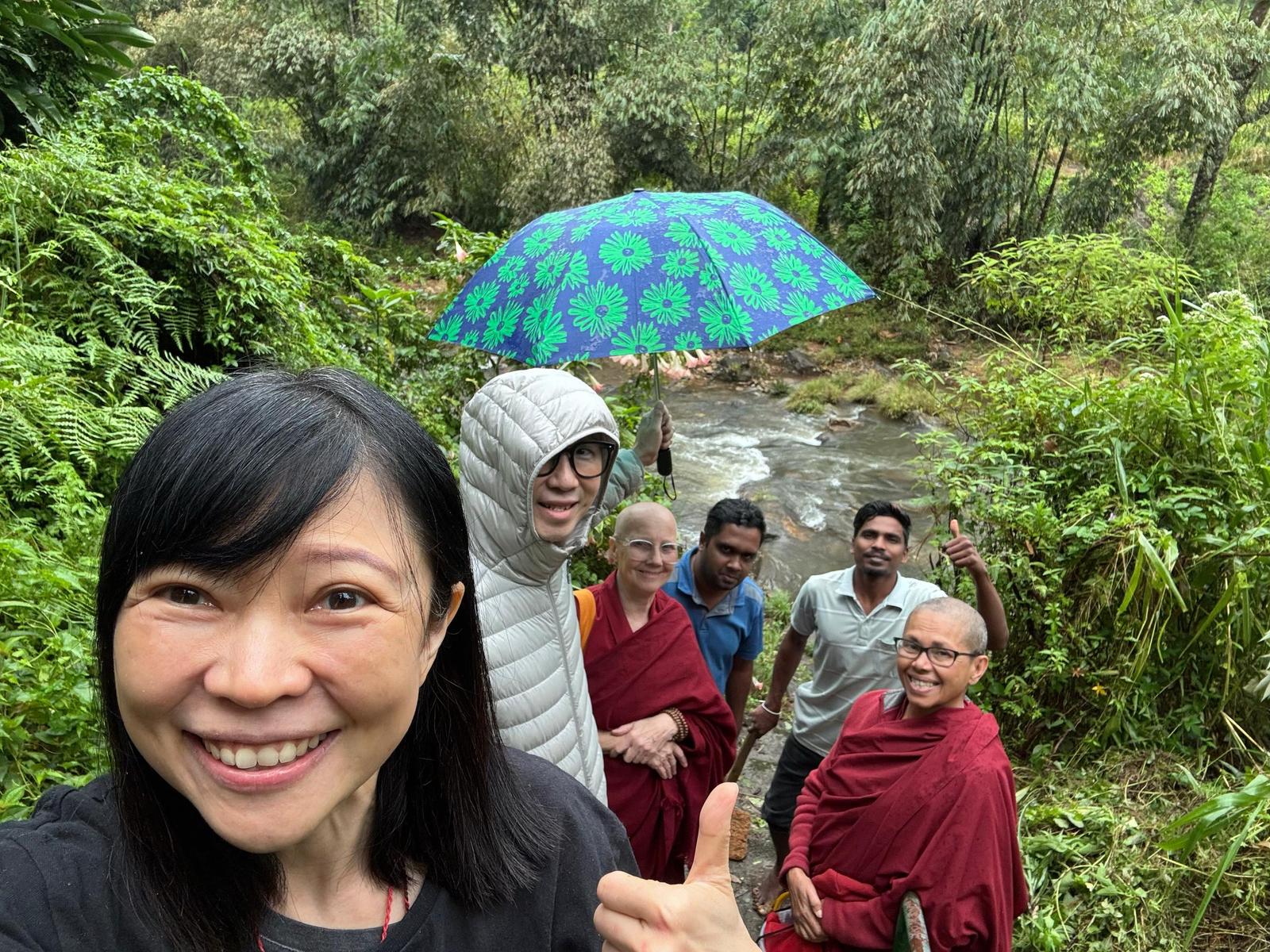
Pilgrimage participants after planting an Earth Treasure Vase on Sri Pada mountain in Sri Lanka, April 2025. Photo courtesy Tara Lanka Study Group.
A Sacred Climb: Pilgrimage to Sri Pada
By Ven. Tenzin Lekdron
In April 2025, a small but determined group of seven pilgrims gathered in Sri Lanka to ascend the sacred mountain Sri Pada—known also as Adam’s Peak, Mount Malaya, or Samanala Kanda. The journey was not just physical but deeply spiritual, resulting from a request by Palchen Rinpoche who had been unable to travel from Tibet. His students in Singapore entrusted an Earth Treasure Vase (meant for replenishing the Earth) to FPMT Tara Lanka Study Group, requesting it be buried near Sri Pada as part of a global healing practice.
For two years, attempts were made to find a qualified lama to do the burial ritual—until Geshe Rabten of the FPMT Atisha Centre in Bendigo, Australia, told me: “You must do it.”
Thus began a journey marked by obstacles. The pilgrimage season was ending, the rains had begun, and some original participants withdrew due to illness or misunderstandings. Friends become strangers. At one point, it seemed the climb would be a solitary one. And yet, two strangers from Malaysia joined at the last minute, drawn by their devotion to Guru Rinpoche.
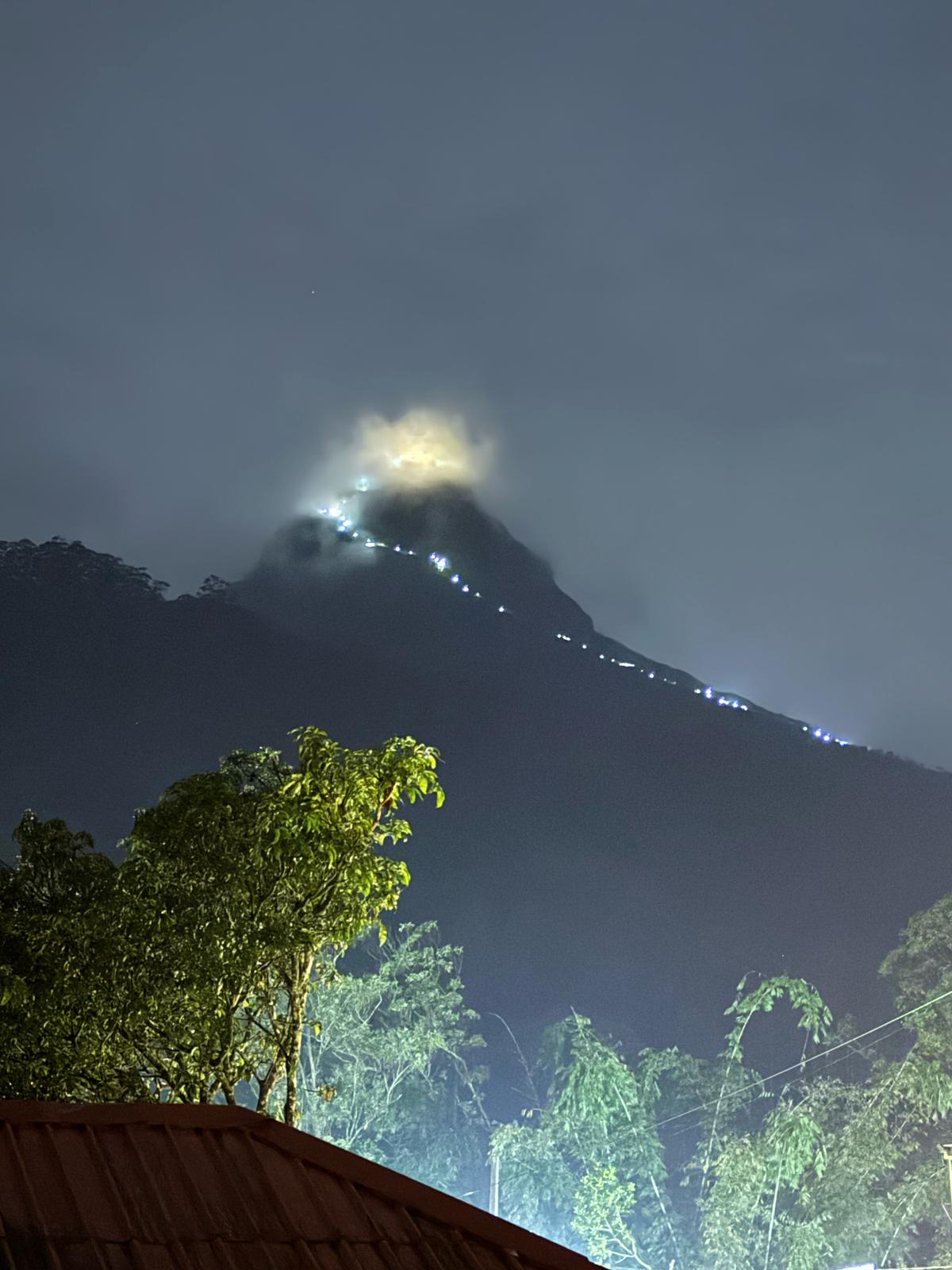
View of Sri Pada mountain at night. Photo courtesy Ven. Tenzin Lekdron.
Ven. Dechen Molly recalls the surreal beauty of the moment: “We knelt side by side in silence. The air was charged with blessing.” But it was no small feat. “The descent was brutal on the knees. We walked backwards at times, like climbing down a ladder.”
Despite the fatigue, the pilgrims completed their mission. Between cloudbursts, they buried the Earth Treasure Vase. Prayers continued, and in an act of compassion, a chicken destined for slaughter was bought and released.
For Eddie, the pilgrimage became a lesson in letting go. “I kept waiting to ‘arrive’—at the summit, at breakfast, at rest. But that desire for resolution kept me from seeing the moment. I realized the journey was the goal.” Ven. Dechen added with a smile, “And the veggie burger made with banana flower? Absolutely delicious.”
It was also extra special for three Sri Lankan pilgrims. Ruwan Basnayaka said, ”Although I had climbed Sri Pada before, this time it had a bonus attached as we were connecting with the second Buddha, Guru Padmasambhava. During the practices we felt the energy and constant reminders from the two nuns —to remember we are climbing on behalf of all sentient beings— made me think differently about the physical hardship.”
The ripple effects of the pilgrimage are still unfolding. New locations, fresh enthusiasm, and revived Dharma efforts now mark the work of Tara Lanka Study Group. What began with uncertainty has become a story of perseverance, interdependence, and the spontaneous blessings that arise when intention meets faith.
To me, this was never just about climbing a mountain. It was about removing obstacles—personal, logistical, spiritual. And since returning, stalled projects have begun to move forward. One of the projects is the sponsorship of the revised translation of one of the island’s greatest unsung treasures from its ancient past, the Manjusri Vasthu Vidya Shasthra, the only version discovered anywhere. This text contains instructions for building Buddhist monastic complexes and Buddha statues, and is a very important text showing the extent of Mahayana practice in Sri Lanka. This stalled project is moving again with Sri Lankan scholar Bertram Liyanage’s incredible help with Sanskrit and English corrections, and the kind generosity of a sponsor.
The Earth Treasure Vase now rests in the shadow of Sri Pada, surrounded by the wild forest and sacred echoes. The journey continues—for the mountain, the pilgrims, and the island itself.
Venerable Tenzin Lekdron is a Sri Lankan-born Australian Buddhist nun in the Tibetan tradition. A long standing student of Lama Zopa Rinpoche, she was ordained by His Holiness the Dalai Lama in 2016. She founded the Tara Lanka Foundation to create unification and harmony across Theravada and Mahayana Buddhist traditions. For the past three years, she has been working on making Lama Zopa’s vision for healing and unity a reality by raising funds for archeological research and documentation of Mahayana traditions that have been lost over time. In 2023, Lama Zopa Rinpoche gave her the significant task of bringing Baisajyaguru (Medicine Buddha) back to Sri Lanka.
Please read a previously published story about a pilgrimage Ven. Lekdron led in Sri Lanka to raise funds for the 5MB Project, a mission to build a five-story high Medicine Buddha statue in Sri Lanka, according to the instructions of Lama Zopa Rinpoche.
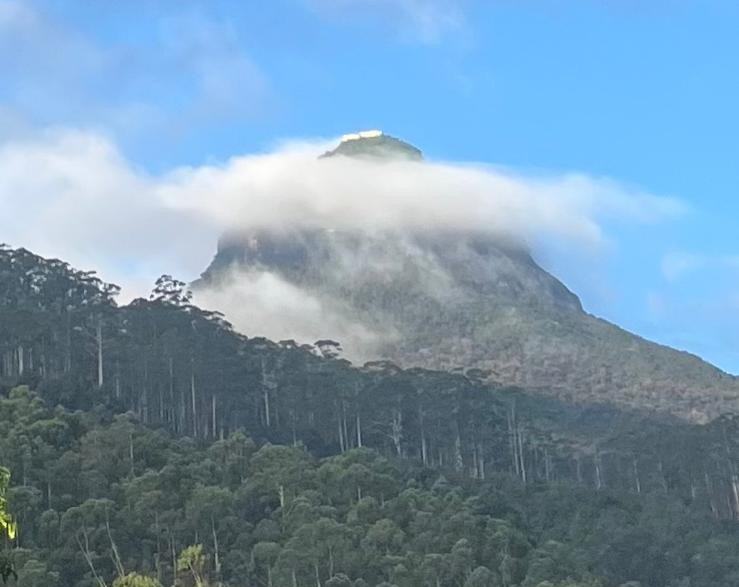
Sri Pada mountain, the place where the Buddha taught the Lankavatara Sutra. Photo courtesy Tara Lanka Study Group.
Reminiscences of a Sri Pada Pilgrim
By Eddie Yap
Wow! Wow! Wow! Echoes of Kyabje Lama Zopa Rinpoche’s voice were vividly heard in my mind. As we sat together at the café of Adam’s Peak Inn on a rainy afternoon after the hike, we shared our experiences of the amazing hike of Sri Pada. It is unfathomable because of the auspicious causes and conditions that brought us together and the perfect weather conditions that we enjoyed during the hike. As cliché as it sounds, we felt like in a dream and an illusion…
Adam’s Peak or Sri Pada has a height of 2,243 metre (7,359 feet). The ascent to the peak takes 5,500 steps, measuring about 7.5 km (4.5 miles) in distance. The mountain is also known as Mount Malaya, where the Buddha Shakyamuni taught the Mahayana Lankavatara Sutra. This incredible sacred site also marks the origin of Vajrayana teachings. For more information about the mountain, please refer to www.nekhor.org and Wikipedia.
On April 9, 2025, at 12:30 a.m. we started our walk from the Adam’s Peak Inn to the foothill of the Sri Pada. We reached the peak about 5:30 a.m., just in time for paying homage at the temple. We did our prayers and watched the sunrise at 6 a.m. We started to descend around 6:30 a.m. and each of us arrived at the Adam’s Peak Inn at varied times. It took me about 9 hours to complete the entire pilgrimage of Sri Pada. I am indeed grateful for the blessings of my Guru and Three Jewels, Venerable Lekdron, Venerable Dechen, and to my fellow pilgrims who showered me with unconditional love, joy, support, and care.
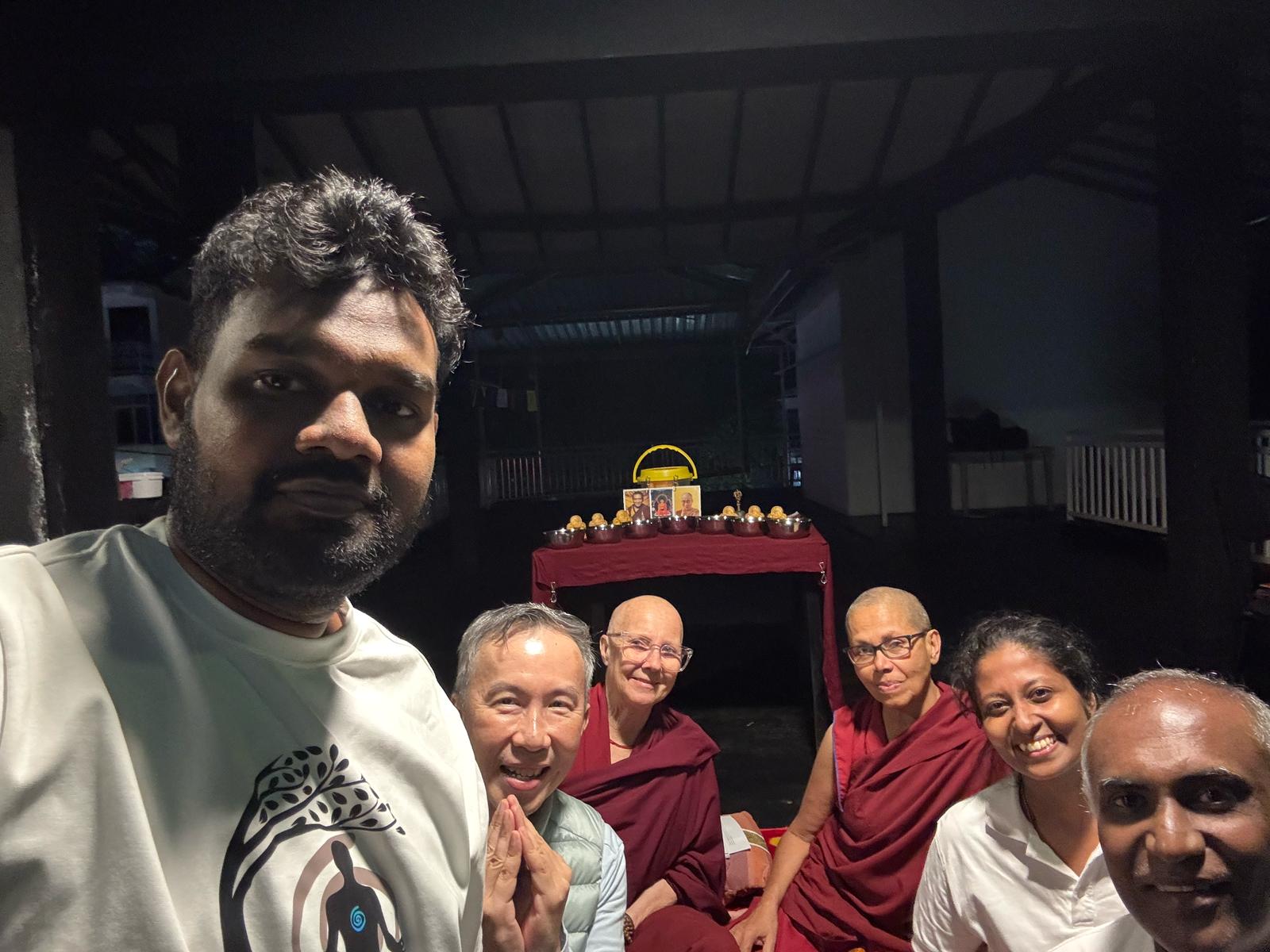
Pilgrimage participants completing prayers before climbing Sri Pada mountain. Photo courtesy Tara Lanka Study Group.
As indescribably fruitful as the midnight hike is for my inner transformation, I was perturbed with anxiety and doubts in the beginning. My thoughts were like… what if I can’t cope with lack of sleep and fatigue? Will my knapsack be too heavy if I pack too much water, warm clothes, medicine, etc.? Will it rain? Will it be very crowded with pilgrims on the way up like what I saw on YouTube? Countless ruminations on my mind that I cannot even recall.
If you ask me how I did it, I cannot pinpoint any specific method. Perhaps Nike’s slogan of “Just do it” helps; or our team camaraderie, brimming with love and care that pushed me to take another step after another. Or when I was stuck halfway, I had no choice but to continue. Or perhaps meeting an 80-year-old lady who hiked Sri Pada eight times in her life, descending a step at a time in the dark of the night with much joy and vigor that inspired me. It is awe inspiring to witness various causes and conditions working together … I think I am in control and yet I am vulnerable too. So, I just suck it up and take a moment to reflect on the wondrous opportunity that I am experiencing. Maybe it is not about reaching the summit that really matters. It is the journey. Pausing, enjoying the surrounding, laughing, succumbing to the pain of fatigued muscles, taking deep breaths and marveling at how far I have climbed and descended.
Along the way, Ven. Lekdron gently reminded me of our altruistic aspirations. For the benefit of all sentient beings, may all beings have happiness and its causes, may all beings be free from suffering and its causes. Think of the six classes of beings who are with us on this journey. Any pain that I feel is far less than those felt by hell beings. Bodhichitta, the essence of Buddha Dharma, is my inconceivable propulsion. Balancing my capacity to help others and myself is a constant juggle. I have learnt to be compassionate to my experiences and allow changes to happen. During the hike, I am reminded of the airplane emergency procedures. I must wear the oxygen mask first, then help others. I have to be safe before helping others, I have to be kind to myself to be kind to others.
The nine-hour journey is filled with lucid and transient sweet and bitter moments. Truly exceptional opportunities to discover endless discomfort that came and went. When I was on my way up, I thought of when I would reach the top and, on my way down, when would I arrive at the Inn for a warm breakfast. Dissatisfaction pervaded my state of mind. Habitually, I was not contented with every moment of my experience. As long as I wanted a preconceived and permanent outcome, I was dissatisfied.
I recalled the inspiring stories of Ven. Lekdron and Ven. Dechen over our meals together. Their relentless pursuit of Dharma activities and the numerous challenges that they had to deal with. Perhaps the goal is the path. Perhaps I shall appreciate the spontaneity of each moment of experience. Discover the transitory nature of life. Not everything has to make sense from my meager perspective. Live a larger life. It is not always about me. Whatever I feel or perceive is only a minute part of what it really is. My experience is dependent on a multitude of factors that I cannot possibly know. Learn to live with discomfort and dissatisfaction as the path. I do not need to create pleasant experience. Be open to all experiences. Appreciate the interdependence, ever changing and multiple outcomes of causes and conditions. Be in love with the world. Be creative. Be kind.
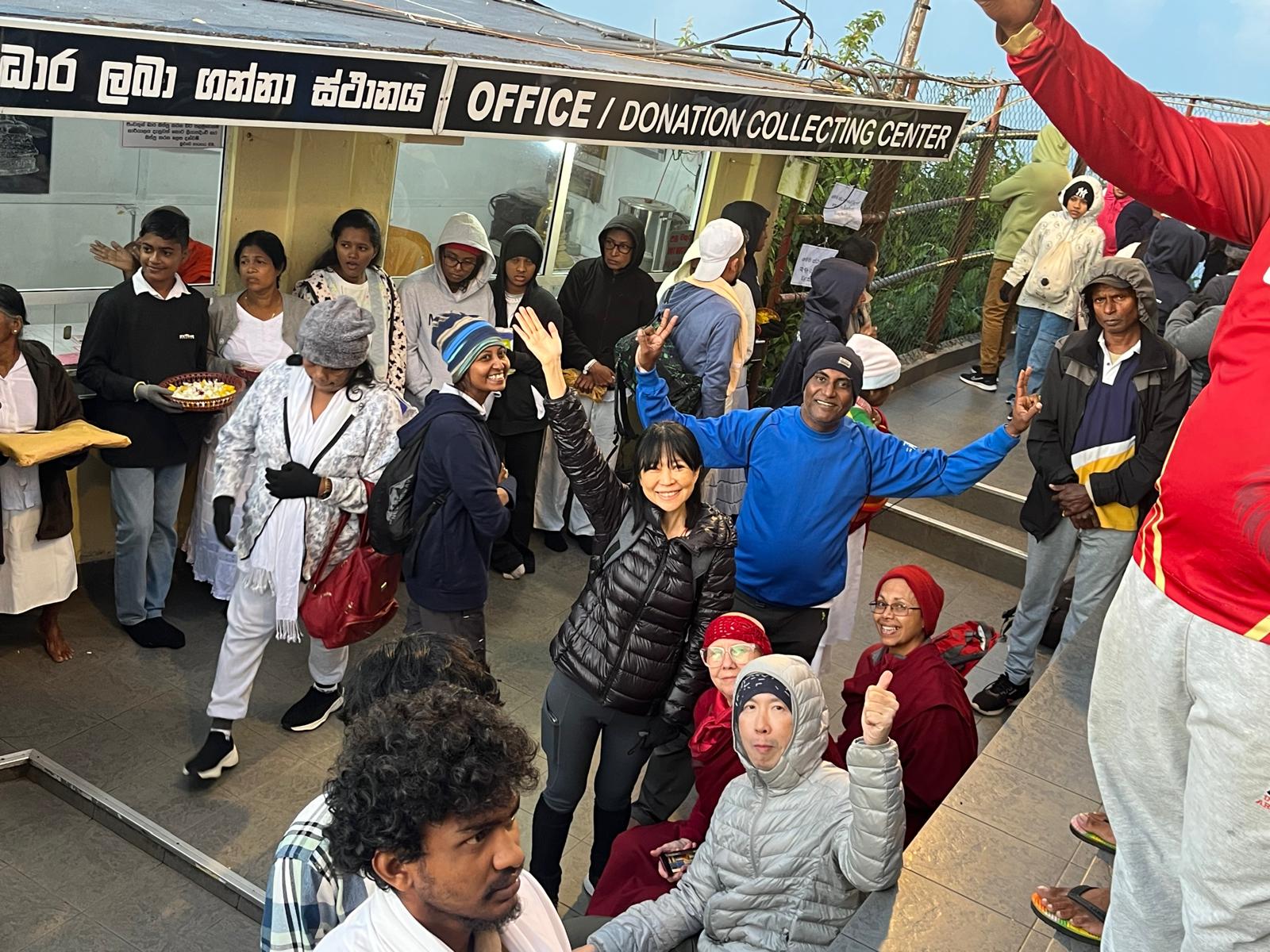
Tara Lanka Study Group pilgrimage participants at the summit of Sri Pada mountain. Photo courtesy Tara Laka Study Group.
I wish to extend my heartfelt gratitude to the wise and compassionate Ven. Lekdron and Ven. Dechen for their guidance and teachings. It is an amazing experience to eat and live with unique and exemplary bodhisattvas like them. It is certainly a wish fulfilling pilgrimage that I have much to learn from. My experience at Sri Pada would not be as lovely and memorable without the love, care and unwavering support from my fellow pilgrims who I am truly thankful for. The journey continues…
Humbly with lots of love,
Eddie
Eddie Yap lives in Malaysia and is a member of Losang Dragpa Center in Kuala Lumpur, Malaysia. He has traveled to many sacred sites of Guru Rinpoche (Padmasambhava).
We welcome the submission of news stories from those within the FPMT community. This can be a story about something you have personally completed or accomplished, about someone else who has done so, or about the FPMT center, project, or service of which you are a part. Ideal submissions will give readers reasons to rejoice, share ideas, and create connections between those in the international community. Have something to share? Please let us know!
Foundation for the Preservation of Mahayana Tradition (FPMT), is a Tibetan Buddhist organization dedicated to the transmission of the Mahayana Buddhist tradition and values worldwide through teaching, meditation and community service.
- Tagged: sri lanka, tara lanka study group
10
Ask a Teacher: Addressing Doubt

Ven. Gache explaining quantum physics to the senior monks at Sera Jey, January 2024/
Ven. Tenzin Gache, FPMT registered teacher and current director of Sera IMI House in South India, recently took the time to thoughtfully answer this question from a student: “How can we gain confidence in aspects of the Buddha’s teachings that are not accessible to our perception, for example, reincarnation?” As this question is familiar to all of us wishing to establish deep faith in Buddha’s teachings, we share his full answer below.
Addressing Doubt in the Buddha’s Teachings
By Ven. Tenzin Gache
Tibetan Buddhists in general, and especially followers of Je Tsongkhapa, consider themselves inheritors of the “Nalanda Tradition” that arose in ancient India. The trademark approach is critical investigation, rather than reliance on faith and adherence to established conventions. To question fundamental tenets of the Buddha’s teachings is not considered “bad karma” but is instead a dutiful display of respect for the lineage. This attitude is reflected in these passages, two attributed to the Buddha himself, and one from a contemporary master:
“It is fitting for you to be perplexed, Kalamas, fitting for you to be in doubt. Doubt has arisen in you about a perplexing matter. Come, Kalamas, do not go by oral tradition, by lineage of teaching, by hearsay, by a collection of scriptures, by logical reasoning, by inferential reasoning, by reasoned cogitation, by the acceptance of a view after pondering it, by the seeming competence [of a speaker], or because you think ‘the ascetic is our guru.’ But when you know for yourselves: ‘These things are wholesome; these things are blameless; these things are praised by the wise; these things, if accepted and undertaken, lead to welfare and happiness,’ then you should live in accordance with them.”[1] [“Logical reasoning” here is understood as reasoning divorced from empirical investigation, and does not imply that reasoning in general is not a necessary tool.]
Oh monks and scholars, as you would
test gold by burning, cutting, and
by rubbing it, just so accept
my words: not through respect for me.[2]
If scientific analysis were conclusively to demonstrate certain claims in Buddhism to be false, then we must accept the findings of science and abandon those claims.[3]
The Nalanda masters identified two possible approaches to the teachings: the “dull faculty” approach of faith or trust in a person, and the “sharp faculty” approach of critical analysis and trust in reasoning. Those who employ the first approach gain faith and enter the path more quickly, but those taking the second approach eventually gain an unshakable faith and, though slower to begin the path, will ultimately reach enlightenment far more quickly.
The second quotation above is seen as the source for the “sharp” approach, and later masters such as Aryadeva and Dharmakirti broke the advice into three parts, corresponding to three levels of analysis for three potential objects of knowledge:
- “Burning” symbolizes testing the manifestly obvious aspects of the teachings against our direct experience. If we can verify through sense consciousness (including with a microscope) that something the Buddha said does not accord with reality, we can and should discard it.
- “Cutting” symbolizes testing the slightly hidden aspects of the teachings against reason. The Buddha may have spoken of something we cannot directly experience, yet this teaching does not withstand reasoned analysis, we can discard it.
- “Rubbing” symbolizes checking the very hidden aspects of the teachings for internal contradiction. In some cases, the Buddha may have spoken of something that is only accessible to clairvoyance. We might not be able to test it against our experience or against reason, but if the teaching contradicts itself or another teaching the Buddha gave, we can put it aside.
A key point here is that it is considered inappropriate to employ a later stage of analysis at an earlier step. For example, if something is accessible to reasoning, we cannot appeal to textual authority to verify it. This is not simply a rule but reflects the stepwise approach. We always start with the earlier stages, so if something was accessible to reason, we would have already confirmed or rejected it before reaching the last stage. We only appeal to authority when something is beyond our ability to reason—and even then, we do so only with significant caution, as I will explain below.
The heart of the Buddha’s teachings is the four noble truths, and this teaching is the fulcrum upon which we weigh the other teachings. The four noble truths are a slightly hidden phenomenon, accessible to reason. If we have not used reason to establish these, then we have no basis for judging more esoteric claims. Critically, the teaching on karma and reincarnation forms an essential element of the four truths, as the interplay between the origin of suffering—karma and delusion—and the resultant suffering—aggregates arising under the power of karma and delusion. Reincarnation is something we must approach through critical analysis and not by appeal to the Buddha or someone else’s authority.
This point is sometimes misunderstood because certain teachings on karma are used as examples of very hidden phenomena. But the important distinction is between an understanding of karma in general rather than the result of a particular action. For example, in one sutra the Buddha claims that a particular lay supporter will be reborn as a monkey due to derogatorily calling an arhat a monkey. Although we can understand in a general sense that a concordant cause might lead to a particular concordant result, to know with certainty the result of any action we would need to know the details of all the myriad factors involved. What was the motivation behind the statement? Did the speaker regret it afterward? What other actions did he do in this or other lives that might be more powerful and override this action as the cause for the next birth? These are questions that can only be answered with profound clairvoyance. This distinction is analogous to predicting the weather—we can establish through reason and investigation the general patterns of meteorology, and make informed estimates about next week’s weather, but to know for sure that there will be a thunderstorm on Sunday would require knowing a nearly infinite interplay of causes.
If karma and reincarnation are accessible to reasoning, how can we approach them? The traditional teachings speak of employing either reason or scriptural quotation, but I think that today we can also talk about appeal to evidence. Ultimately our interpretation of evidence will depend on our use of reasoning, but gathering evidence in support of a hypothesis is in line with the dictum that we first appeal to direct perception. There is a wealth of high-quality evidence available, and a good introduction to the field can be found in Rebirth in Early Buddhism & Current Research by Bhikkhu Analayo.[4]
To use reasoning, we can first step back and ask, “What kind of world would have to be possible to allow for reincarnation?” A universe functioning solely according to the laws of classical physics would not allow for a nonmaterial mind to have any causal efficacy in the material world. Furthermore, a purely material mind—one that is either identical with, or a byproduct of, the brain—would not exist before birth and would cease at the time of death. These two notions—a classical universe and a material mind—are both ones that we can approach through reasoning and study of the available evidence. As serious practitioners of Buddhism, it is our responsibility to pursue such an approach, rather than appeal to either the authority of traditional Buddhist masters on the one side, or modern materialist scientists and philosophers on the other. This issue is too critical to the heart of Buddhism—to the truth or untruth of the four noble truths—for us to decide on hearsay. It is beyond the scope of this current essay to address the argument in detail, so I will do so in a subsequent one. The key point is that such investigation is not a diversion from serious practice but constitutes the practice of analytical meditation. The Buddha described practice as comprising study, contemplation, and meditation. What subject is more crucial to study and contemplate than the four noble truths? Liberation in Buddhism comes through wisdom seeing things as they are, not through reciting the right mantra formula or abiding in single-pointed concentration. These other practices can be utilized as powerful supplements for the development of wisdom but are not intended as replacements.
Finally, we come to the question of how to examine very hidden phenomena. Predicting specific details of karmic causation, like unfolding weather patterns, requires detailed knowledge of seemingly countless causes and conditions. Sense perception and even reasoned analysis alone cannot reveal these details. When the Buddha makes a claim about the karmic effect of a particular action, or the past cause leading to a present result, can we accept the statement as valid? The claim might not be “falsifiable” in the strict sense, but Nalanda masters developed tools that we can use to analyze the statement for potential flaws. Some traditional accounts speak of Mount Meru at the center of the universe. Mount Meru, if it exists, is not a very hidden phenomenon—it ought to be accessible to direct perception. If we use modern telescopes and other reliable devices and cannot perceive it, we can comfortably put such statements aside without controverting our adherence to Buddhist principles. We can also use modern methods of textual analysis to question the source of many statements, rather than assuming that any sutra attributed to the Buddha was indeed spoken by him. Tsongkhapa himself took such an approach in analyzing Indian texts, making maximum use of the tools available in fifteenth century Tibet.
In some sutras we see statements like “merely by reciting the name of Amitabha, you will be reborn in Sukhavati.” The Nalanda masters considered such a statement interpretable, meaning it cannot be taken literally because it contradicts teachings that can be verified by reasoning. If merely reciting the name of Amitabha led to birth in Sukhavati, there would be little need for cultivating ethical discipline, concentration, and insight. Karmic causation would essentially be nullified, because every other action a person did in their lifetime would have no bearing. The masters did not reject this statement but interpreted it in a nonliteral way. The teaching was meant for those who are easily discouraged, to uplift their spirits. The intention was not that simply reciting Amitabha’s name once would immediately lead to birth in Sukhavati after death, but that it would create a positive imprint that could lead to evolution over many, many lifetimes, eventually culminating in that result.
The Buddha’s claim that a particular lay adherent would be born as a monkey in the next life does not contradict his earlier teachings and is plausible within the framework of karmic causation. Does that mean that we can accept it? For one thing, to determine that it is plausible within that framework requires a deep understanding of the teachings on karma, and a conviction in their efficacy based on previous investigation. It also requires an understanding of what enlightenment is, and a conviction that the Buddha was an enlightened being. None of these points—the efficacy of karma, enlightenment in general, and even the Buddha’s enlightenment—is a very hidden phenomenon. Even if a practitioner has generated genuine valid cognition toward these points, it is questionable whether their conviction in the truth of the specific statement can ever reach the level of incontrovertibility that we can reach through reasoned analysis. The Geluk authors did indeed call such a conviction an “inference through belief,” but it is unclear whether Dharmakirti and his Indian contemporaries considered this sort of inference as on par with inference through the power of reason. In any case, we can be honest with ourselves about the limits of our knowledge. It is always possible that a statement attributed to the Buddha was not spoken by him. Even if it was, it is possible that he meant it in an allegorical way, as a skillful means to address the needs of disciples at the time. Even if it was meant literally, ascertaining its veracity hinges on conviction that the Buddha himself was infallible. This latter sort of conviction is not something that we can base on authority, but something that we must investigate with reasoning, taking us right back to the second stage of examining slightly hidden phenomena. Especially in the modern world, where there is a strong emphasis on questioning and reliable corroboration of unconventional claims, we as Buddhist practitioners cannot afford to lean on the authority of the past. We need courage and diligence to examine things for ourselves. We don’t pursue such examination just to convince others, but to confront our own doubt and work with our own minds. Doubt doesn’t leave us bewildered but clears a path that can lead to incontrovertible certainty when we are brave enough to follow that path as far as it will go.
Ven. Tenzin Gache is originally from Boston and graduated from Tufts University in 2005. During his college years he became a student of Lama Zopa Rinpoche and Choden Rinpoche. In 2006 he ordained with His Holiness the Dalai Lama, and has lived and studied at Sera Jey Monastery since that time. Currently he is in the final year of the standard geshe studies program, and next year will begin the intensive exams to qualify for the title of lharampa geshe.
[1] From the Kalama Sutta, found in Bhikkhu Bodhi, 2012. The Numerical Discourses of the Buddha. Boston: Wisdom Publications, p. 281.
[2] I have translated this verse from the Tibetan as it appears in Rje Tsong kha pa, 2002. Drang ba dang nges pa’i don rnam par ‘byed pa’i bstan bcos legs bshad snying po. Taiwan: The Corporate Body of the Buddha Educational Foundation, p. 3. Ironically, locating its original source within the Buddha’s teachings is a controversial matter, and most Tibetan scholars cited the quotation as it appears in an extant commentary by the Indian master Shantarakshita. Regardless of whether the Buddha made this exact statement, it certainly reflects themes he espoused in many other discourses.
[3] His Holiness the Dalai Lama, 2005. The Universe in a Single Atom. New York: Morgan Road Books, p. 3.
[4] Bhikkhu Analayo, 2018. Rebirth in Early Buddhism & Current Research. Boston: Wisdom Publications.
6
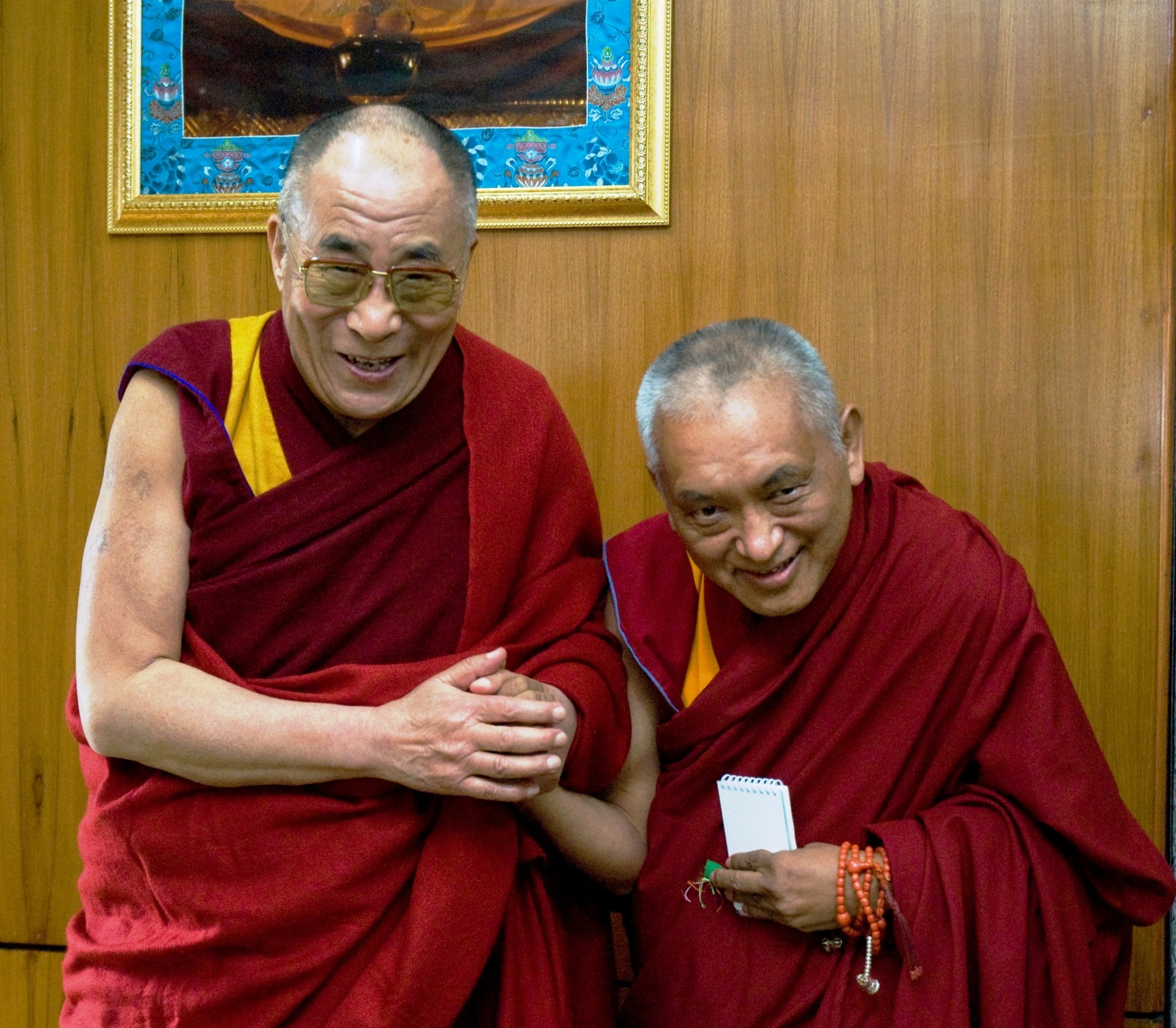
His Holiness the Dalai Lama with Lama Zopa Rinpoche, 2008.
We join students, friends, and admirers around the world in wishing His Holiness the Dalai Lama every good wish imaginable on his ninetieth birthday! A voice for the voiceless, a light in the dark, a complete and total manifestation of compassion for every living being—Your Holiness, please, please live long in this life; and in all future lives please continue to guide all of us who so desperately need your perfect example of kindness, patience, humility, and skillful means toward universal peace in the world.
For more on His Holiness the Dalai Lama and his beneficial activities, please visit DalaiLama.com.
Foundation for the Preservation of Mahayana Tradition (FPMT), is a Tibetan Buddhist organization dedicated to the transmission of the Mahayana Buddhist tradition and values worldwide through teaching, meditation and community service.
- Tagged: his holiness, his holiness the dalai lama
4
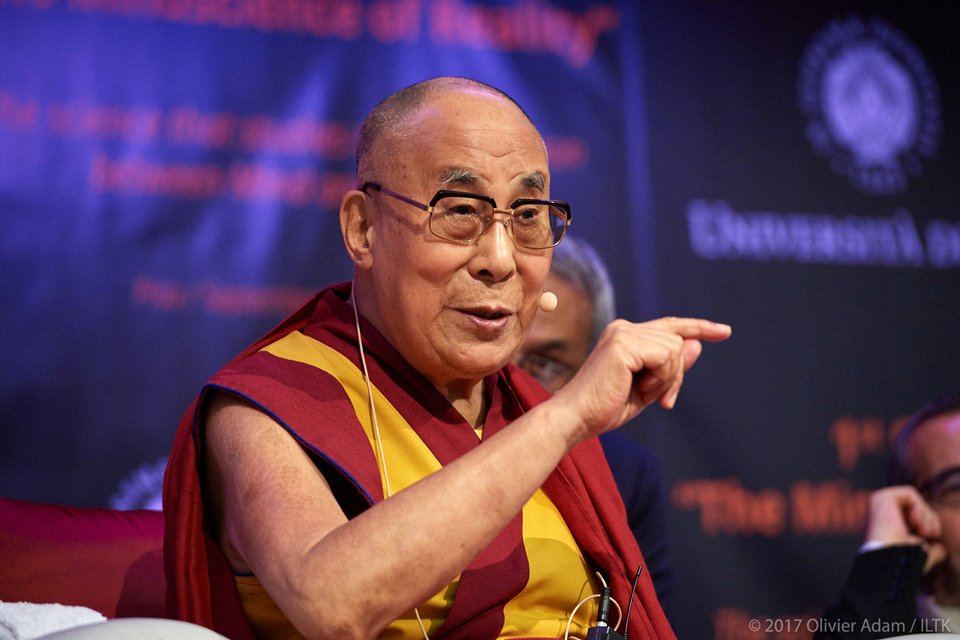
His Holiness the Dalai Lama at the Mind Science of Reality Symposium, organized by Istituto Lama Tzong Khapa and Università di Pisa, Pisa, Italy, September 2017. Photo by Olivier Adam.
The time has come for students, friends, and supporters around the world to join together in celebrating the ninetieth birthday of His Holiness the Fourteenth Dalai Lama of Tibet, which occurs this year on July 6, 2025. We recently shared several resources available to enrich your practice and observation of this special and auspicious day.
We also wanted to offer one more reminder to please REJOICE that the FPMT organization will be offering one hundred statues of Shakyamuni Buddha to His Holiness during a special long life puja for His Holiness on July 5 in Dharamsala! Five representatives from the FPMT community will be present to offer the statues. Please rejoice and read more about this offering.
About humanity’s need for love and compassion, His Holiness commented:
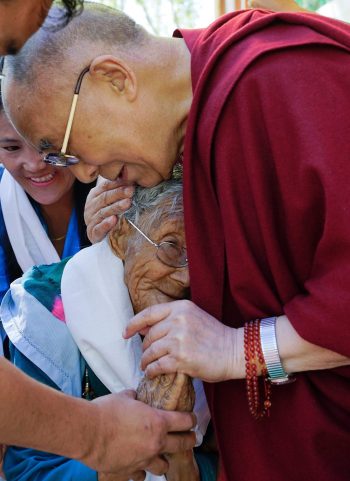
His Holiness the Dalai Lama comforts an elderly woman on the final day of his visit to Leh, Ladakh, India on August 24, 2016. (Photo by Tenzin Choejor/OHHDL)
“Ultimately, the reason why love and compassion bring the greatest happiness is simply that our nature cherishes them above all else. The need for love lies at the very foundation of human existence. It results from the profound interdependence we all share with one another. However capable and skillful an individual may be, left alone, he or she will not survive. However vigorous and independent one may feel during the most prosperous periods of life, when one is sick or very young or very old, one must depend on the support of others.
“Interdependence, of course, is a fundamental law of nature. Not only higher forms of life but also many of the smallest insects are social beings who, without any religion, law or education, survive by mutual cooperation based on an innate recognition of their interconnectedness. The most subtle level of material phenomena is also governed by interdependence. All phenomena from the planet we inhabit to the oceans, clouds, forests and flowers that surround us, arise in dependence upon subtle patterns of energy. Without their proper interaction, they dissolve and decay.
“It is because our own human existence is so dependent on the help of others that our need for love lies at the very foundation of our existence. Therefore we need a genuine sense of responsibility and a sincere concern for the welfare of others.” Please read His Holiness’s full message on Compassion and the Individual.
His Holiness has offered this world ninety years of perfect guidance and inspiration and has served as a true living example of compassion in action, particularly in the face of adversity and unimaginable challenges. May students around the world unite in strong prayers for His Holiness to continue living a strong, stable, and long life for the benefit of all who so desperately need him as a guiding light of universal love.
For more on His Holiness the Dalai Lama and his beneficial activities, please visit DalaiLama.com.
Foundation for the Preservation of Mahayana Tradition (FPMT), is a Tibetan Buddhist organization dedicated to the transmission of the Mahayana Buddhist tradition and values worldwide through teaching, meditation and community service.
- Tagged: his holiness, his holiness the dalai lama
- Home
- News/Media
- Study & Practice
- About FPMT Education Services
- Latest News
- Programs
- New to Buddhism?
- Buddhist Mind Science: Activating Your Potential
- Heart Advice for Death and Dying
- Discovering Buddhism
- Living in the Path
- Exploring Buddhism
- FPMT Basic Program
- FPMT Masters Program
- FPMT In-Depth Meditation Training
- Maitripa College
- Lotsawa Rinchen Zangpo Translator Program
- Universal Education for Compassion & Wisdom
- Online Learning Center
- Prayers & Practice Materials
- Overview of Prayers & Practices
- Full Catalogue of Prayers & Practice Materials
- Explore Popular Topics
- Benefiting Animals
- Chenrezig Resources
- Death & Dying Resources
- Lama Chopa (Guru Puja)
- Lama Zopa Rinpoche: Compendium of Precious Instructions
- Lama Zopa Rinpoche: Life Practice Advice
- Lama Zopa Rinpoche Practice Series
- Lamrim Resources
- Mantras
- Prayer Book Updates
- Purification Practices
- Sutras
- Thought Transformation (Lojong)
- Audio Materials
- Dharma Dates – Tibetan Calendar
- Translation Services
- Publishing Services
- Teachings and Advice
- Find Teachings and Advice
- Lama Zopa Rinpoche Advice Page
- Lama Zopa Rinpoche: Compendium of Precious Instructions
- Lama Zopa Rinpoche Video Teachings
- ༧སྐྱབས་རྗེ་བཟོད་པ་རིན་པོ་ཆེ་མཆོག་ནས་སྩལ་བའི་བཀའ་སློབ་བརྙན་འཕྲིན།
- Podcasts
- Lama Yeshe Wisdom Archive
- Buddhism FAQ
- Dharma for Young People
- Resources on Holy Objects
- Ways to Offer Support
- Centers
- Affiliates Area
- Teachers
- Projects
- Charitable Projects
- Make a Donation
- Applying for Grants
- News about Projects
- Other Projects within FPMT
- Support International Office
- Projects Photo Galleries
- Give Where Most Needed
- FPMT
- Shop
Translate*
*powered by Google TranslateTranslation of pages on fpmt.org is performed by Google Translate, a third party service which FPMT has no control over. The service provides automated computer translations that are only an approximation of the websites' original content. The translations should not be considered exact and only used as a rough guide.Unlike an external enemy, the inner enemy cannot regroup and launch a comeback once it has been destroyed from within.







